High Flying Electronics Technology HF-LPB Embedded WIFI module User Manual AZY HF LPB Rev1
High-Flying Electronics Technology Co.,Ltd Embedded WIFI module AZY HF LPB Rev1
AZY-HF-LPB_User Manual Rev1
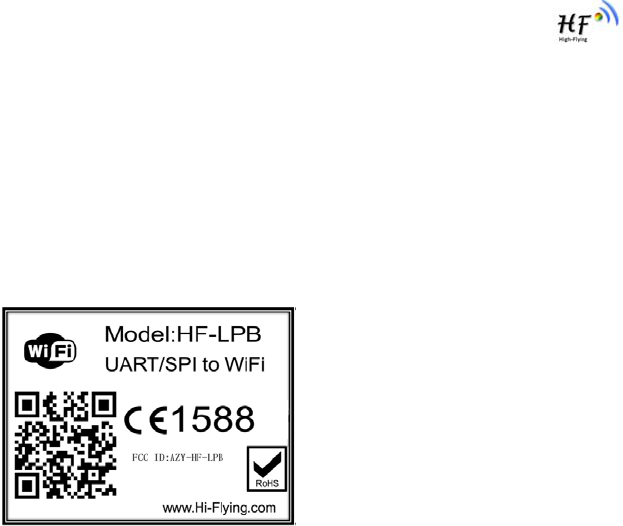
HF-LPB Low Power WiFi Module User Manual
Shanghai High-Flying Electronics Technology Co., Ltd
www.hi-flying.com
- 1 -
HF-LPB
Low Power WiFi Module User Maunal
V 1.1
Copyright
Hi-flying is a registered trademark of Hi-flying Incorporated. Copyright ©
2012 Hi-flying Incorporated. All rights reserved. No part of this publication
may be reproduced or distributed in any form or by any means, or stored
in a database or retrieval system, without the prior written permission of
the publisher. Hi-flyin
g
Incorporated reserves the ri
g
ht to make chan
g
es in
technical and product specifications without provisional notification. This
module is limited to OEM installation only and must not be sold to end-
users. OEM integrators must be instructed to ensure that the end-user has
no manual instructions to remove or install the device. The end-user can
not remove or install this module to any other devices.
Changes or modifications not expressly approved by the manufacturer
could void the user’s authority to operate the equipment.
If the FCC ID of the module cannot be seen when it is installed, then the
host label must include the text: Contains FCC ID: AZY-HF-LPB

HF-LPB Low Power WiFi Module User Manual
Shanghai High-Flying Electronics Technology Co., Ltd
www.hi-flying.com
- 2 -
Overview of Characteristic
Support IEEE802.11b/g/n Wireless Standards
Fully Self-Contained Serial-to-Wireless Functionality
Ultra-Low-Power for Battery Applications with Excellent Power Save Scheme
Support UART/SPI/USB/PWM/GPIO Data Communication Interface
Support Work As STA/AP/AP+STA Mode
Support Wi-Fi Direct
Support WPS Function
Support Wireless and Remote Firmware Upgrade Function
Support User-Defined Web Page Upload
Single +3.3V Power Supply
Smallest Size: 23mm x 32.5mm x2.7mm
FCC/CE Certificated
TABLE OF CONTENTS
LIST OF FIGURES ................................................................................................................................... 6
LIST OF TABLES .................................................................................................................................... 7
HISTORY .................................................................................................................................................. 7
1.PRODUCT OVERVIEW ................................................................................................................ 8
1.1.General Description ................................................................................................................. 8
1.1.1Device Features .................................................................................................................. 8
1.1.2Device Paremeters ............................................................................................................. 9
1.1.3Key Application ................................................................................................................... 9
1.2.Hardware Introduction ..........................................................................................................10
1.2.1.Pins Definition ...................................................................................................................10
1.2.2.Electrical Characteristics ..................................................................................................12
1.2.3.Mechanical Size ................................................................................................................12
1.2.4.On-board Chip Antenna ....................................................................................................13
1.2.5.Evaluation Kit ....................................................................................................................14

HF-LPB Low Power WiFi Module User Manual
Shanghai High-Flying Electronics Technology Co., Ltd
www.hi-flying.com
- 3 -
1.2.6.Order Information ..............................................................................................................15
1.3.Typical Application ................................................................................................................16
1.3.1.Hardware Typical Application ...........................................................................................16
2.FUNCTIONAL DESCRIPTION ..................................................................................................18
2.1.Wireless Networking .............................................................................................................18
2.1.1.Basic Wireless Network Based On AP (Infrastructure) ....................................................18
2.1.2.Wireless Network Based On AP+STA ..............................................................................18
2.1.3.Wi-Fi Direct Network .........................................................................................................19
2.2.Work Mode : Transparent Transmission Mode ..................................................................20
2.3.UART Frame Scheme ............................................................................................................21
2.3.1.UART Free-Frame ............................................................................................................21
2.3.2.UART Auto-Frame ............................................................................................................21
2.4.Encryption ..............................................................................................................................22
2.5.Network Protocal ...................................................................................................................22
2.6.Multi-TCP Link Connection ...................................................................................................23
2.7.Power Save Scheme ..............................................................................................................23
2.8.Parameters Configuration .....................................................................................................25
2.9.Firmware Update ....................................................................................................................25
2.10.GPIO Function ....................................................................................................................25
3.OPERATION GUIDELINE ..........................................................................................................27
3.1.Configuration via Web Accessing ........................................................................................27
3.1.1.Open Web Management Interface ...................................................................................27
3.1.2.System Page.....................................................................................................................27
3.1.3.Work Mode Page ..............................................................................................................28
3.1.4.STA Setting Page .............................................................................................................28
3.1.5.AP Setting Page ...............................................................................................................29
3.1.6.Other Setting Page ...........................................................................................................29
3.1.7.Account Management Page .............................................................................................30
3.1.8.Upgrade Software Page ...................................................................................................30
3.1.9.Restart Page .....................................................................................................................31
3.1.10.Restore Page ................................................................................................................31
3.2.HF-LPB Usage Introduction ..................................................................................................32
3.2.1.Software Debug Tools ......................................................................................................32
3.2.2.Network Connection .........................................................................................................32
3.2.3.Default Parameter Setting ................................................................................................33
3.2.4.Module Debug ..................................................................................................................33
3.3.Typical Application Examples ..............................................................................................34
3.3.1.Wireless Control Application .............................................................................................34
3.3.2.Remote Management Application ....................................................................................35
3.3.3.Transparent Serial Port Application ..................................................................................35
4.AT+INSTRUCTION INTRODUCTION ......................................................................................36
4.1.Configuration Mode ...............................................................................................................36

HF-LPB Low Power WiFi Module User Manual
Shanghai High-Flying Electronics Technology Co., Ltd
www.hi-flying.com
- 4 -
4.1.1.Switch to Configuration Mode ...........................................................................................36
4.2.AT+ Instruction Set Overview ...............................................................................................37
4.2.1.Instruction Syntax Format .................................................................................................37
4.2.2.AT+ Instruction Set ...........................................................................................................38
4.2.2.1.AT+E .............................................................................................................................39
4.2.2.2.AT+WMODE .................................................................................................................40
4.2.2.3.AT+ENTM .....................................................................................................................40
4.2.2.4.AT+TMODE ...................................................................................................................40
4.2.2.5.AT+MID .........................................................................................................................40
4.2.2.6.AT+VER ........................................................................................................................41
4.2.2.7.AT+RELD ......................................................................................................................41
4.2.2.8.AT+Z .............................................................................................................................41
4.2.2.9.AT+H .............................................................................................................................41
4.2.2.10.AT+UART ..................................................................................................................41
4.2.2.11.AT+ UARTF ...............................................................................................................42
4.2.2.12.AT+ UARTFT .............................................................................................................42
4.2.2.13.AT+ UARTFL .............................................................................................................43
4.2.2.14.AT+ UARTTE .............................................................................................................43
4.2.2.15.AT+ SEND .................................................................................................................43
4.2.2.16.AT+ RECV .................................................................................................................43
4.2.2.17.AT+ PING ..................................................................................................................44
4.2.2.18.AT+NETP ..................................................................................................................44
4.2.2.19.AT+ TCPLK ...............................................................................................................44
4.2.2.20.AT+ TCPTO ...............................................................................................................45
4.2.2.21.AT+TCPDIS ...............................................................................................................45
4.2.2.22.AT+WSSSID ..............................................................................................................45
4.2.2.23.AT+WSKEY ...............................................................................................................46
4.2.2.24.AT+ WANN ................................................................................................................46
4.2.2.25.AT+ WSMAC .............................................................................................................46
4.2.2.26.AT+ WSLK .................................................................................................................47
4.2.2.27.AT+ WSLQ ................................................................................................................47
4.2.2.28.AT+WSCAN ...............................................................................................................47
4.2.2.29.AT+ LANN .................................................................................................................47
4.2.2.30.AT+WAP ....................................................................................................................48
4.2.2.31.AT+WAKEY ...............................................................................................................48
4.2.2.32.AT+WAMAC ..............................................................................................................49
4.2.2.33.AT+WADHCP ............................................................................................................49
4.2.2.34.AT+WEBSWITCH .....................................................................................................49
4.2.2.35.AT+PSPAR ................................................................................................................49
4.2.2.36.AT+MSLP ..................................................................................................................50
4.2.2.37.AT+MSOPT ...............................................................................................................50
4.2.2.38.AT+TSPAR ................................................................................................................51
4.2.2.39.AT+WRMID ...............................................................................................................51

HF-LPB Low Power WiFi Module User Manual
Shanghai High-Flying Electronics Technology Co., Ltd
www.hi-flying.com
- 5 -
4.2.2.40.AT+ASWD .................................................................................................................51
5.PACKAGE INFORMATION ........................................................................................................52
5.1.Recommended Reflow Profile ..............................................................................................52
5.2.Device Handling Instruction (Module IC SMT Preparation) ...............................................52
5.3.Shipping Information .............................................................................................................53
APPENDIX A: HW REFERENCE DESIGN ......................................................................................54
APPENDIX B: CONTACT INFORMATION ......................................................................................55
1 STANDARDS AND REGULATORY COMPLIANCE .........................................................................56
1.2Standards and certification...................................................................................................56
1.3FCC certification requirements. ...........................................................................................56
1.4FCC RF exposure requirements ...........................................................................................58

HF-LPB Low Power WiFi Module User Manual
Shanghai High-Flying Electronics Technology Co., Ltd
www.hi-flying.com
- 6 -
LIST OF FIGURES
Figure 1.HF-LPB Demo ..................................................................................................................10
Figure 2.HF-LPB Pins Map .............................................................................................................10
Figure 3.HF-LPB Mechanical Dimension ........................................................................................13
Figure 4.HF-LPB PCB Symbol Size ................................................................................................13
Figure 5.Suggested Module Placement Region .............................................................................13
Figure 6.HF-LPB Evaluation Kit ......................................................................................................14
Figure 7.HF-LPB Order Information ................................................................................................15
Figure 8.HF-LPB Hardware Typical Application .............................................................................16
Figure 9.HF-LPB Basic Wireless Network Structure ......................................................................18
Figure 10.HF-A11 AP+STA Network Structure ................................................................................19
Figure 11.HF-LPB 1:1 P2P Networking ...........................................................................................19
Figure 12.HF-LPB 1:N P2P Networking ..........................................................................................20
Figure 13.HF-LPB Concurrent Operation Networking ......................................................................20
Figure 14.Multi-TCP Link Data Transmition Structure ......................................................................23
Figure 15.Open Web Management page .........................................................................................27
Figure 16.System Web Page ............................................................................................................28
Figure 17.Work Mode Page ..............................................................................................................28
Figure 18.STA Setting Page .............................................................................................................29
Figure 19.AP Setting Page ...............................................................................................................29
Figure 20.Other Setting Page ...........................................................................................................30
Figure 21.Account Page ...................................................................................................................30
Figure 22.Upgrade SW page ............................................................................................................31
Figure 23.Restart Page .....................................................................................................................31
Figure 24.Restore Page ....................................................................................................................32
Figure 25.STA Interface Debug Connection .....................................................................................32
Figure 26.AP Interface Debug Connection .......................................................................................33
Figure 27.“CommTools” Serial Debug Tools ....................................................................................33
Figure 28.“TCPUDPDbg” Tools Create Connection .........................................................................33
Figure 29.“TCPUDPDbg” Tools Setting ............................................................................................34
Figure 30.“TCPUDPDbg” Tools Connection .....................................................................................34
Figure 31.Wireless Control Application .............................................................................................34
Figure 32.Remote Management Application ....................................................................................35
Figure 33.Transparent Serial Port Application ..................................................................................35
Figure 34.HF-LPB Default UART Port Parameters ..........................................................................36
Figure 35.Switch to Configuration Mode ...........................................................................................36
Figure 36.”AT+H” Instruction for Help ...............................................................................................37
Figure 37.Reflow Soldering Profile ...................................................................................................52
Figure 38.Shipping Information .........................................................................................................53

HF-LPB Low Power WiFi Module User Manual
Shanghai High-Flying Electronics Technology Co., Ltd
www.hi-flying.com
- 7 -
LIST OF TABLES
Table 1 HF-LPB Module Technical Specifications ............................................................................... 9
Table 2 HF-LPB Pins Definition ..........................................................................................................10
Table 4 HF-LPB Evaluation Kit Interface Description ........................................................................15
Table 5 HF-LPB IP Stack Features ....................................................................................................22
Table 6 Difference Between Deelp Sleep And Standby Mode ..........................................................24
Table 7 Power Consumption with Different Power Save Mode .........................................................24
Table 8 HF-LPB GPIO Pin Mapping Table ........................................................................................25
Table 9 HF-LPB Web Access Default Setting ....................................................................................27
Table 10 Error Code Describtion ........................................................................................................38
Table 11 AT+ Instruction Set List .......................................................................................................38
Table 12 Reflow Soldering Parameter .................................................................................................52
HISTORY
Ed. V1.0 Created on 1-29-2013.
Ed. V1.1 02-24-2013. Update AT command contents.

HF-LPB Low Power WiFi Module User Manual
Shanghai High-Flying Electronics Technology Co., Ltd
www.hi-flying.com
- 8 -
1. PRODUCT OVERVIEW
1.1. General Description
The HF-LPB is a fully self-contained small form-factor, single stream, 802.11b/g/n Wi-Fi module,
which provide a wireless interface to any equipment with a Serial/SPI/USB interface for data
transfer.HF-LPB integrate MAC, baseband processor, RF transceiver with power amplifier in hardware
and all Wi-Fi protocol and configuration functionality and networking stack, in embedded firmware to
make a fully self-contained 802.11b/g/n Wi-Fi solution for a variety of applications.
HF-LPB support AP+STA wireless networking and support Wi-Fi Direct. HF-LPB also provides
wireless and remote firmware upgrade, which satisfied all kinds of application requirement. HF-LPB
support user defined Web page and can revise the data communication protocol, which reduce much
customer’s software development and customization work.
The HF-LPB employs the world's lowest power consumption embedded architecture. It has been
optimized for all kinds of client applications in the home automation, smart grid, handheld device,
personal medical application and industrial control that have lower data rates, and transmit or receive
data on an infrequent basis.
The HF-LPB integrates all Wi-Fi functionality into a low-profile, 23x32.5x 2.7mm SMT module package
that can be easily mounted on main PCB with application specific circuits.
1.1.1 Device Features
z Single stream Wi-Fi @ 2.4 GHz with support for WEP security mode as well as WPA/WPA2
z Fully self-contained serial-to-wireless functionality.
z Ultra-low-power operation with all kinds of power-save modes.
z Includes all the protocol and configuration functions for Wi-Fi connectivity.
z Support STA/AP/AP+STA Mode
z Support Wi-Fi Direct Mode
z Support WPS
z Support Wireless and Remote Firmware Upgrade Function
z Support User-Defined Web Page Upload
z Integrated chip antenna options.
z Compact surface mount module 23mm x 32.5mm x 2.7mm.
z Full IPv4 and IPv6 stack.
z Low power RTOS and drivers.
z FCC Certified.
z RoHS and CE compliant.
z Single supply – 3.3V operation.

HF-LPB Low Power WiFi Module User Manual
Shanghai High-Flying Electronics Technology Co., Ltd
www.hi-flying.com
- 9 -
1.1.2 Device Paremeters
Table 1 HF-LPB Module Technical Specifications
Class Item Parameters
Wireless
Parameter
s
Certification FCC/CE
Wireless standard 802.11 b/g/n
US Frequency range 2.412GHz-2.462GHz
EU Frequency range 2.412GHz-2.472GHz
Transmit Power
802.11b: +18dBm (Max.)
802.11g: +14dBm (Max.)
802.11n: +11dBm (Max.)
Configurable
Receiver Sensitivity
802.11b: -93 dBm (@11Mbps ,CCK)
802.11g: -85 dBm (@54Mbps, OFDM)
802.11n: -82 dBm (@HT20, MCS7)
Antenna Option Internal:On-board PCB antenna
Hardware
Parameter
s
Data Interface
UART
USB, SPI, PWM…
Others: GPIO, ADC/DAC, RTC…
Operating Voltage 3.1~3.6V
Operating Current
Peak [Continuous TX]: ~200mA
Normal [WiFi ON/OFF, DTIM=100ms]:
Average. ~5mA, Peak: 200mA
Deep Sleep: [WiFi OFF]: ~2mA
Standby [WiFi Shutdown]: <2uA
Operating Temp. -40℃- 85℃
Storage Temp. -45℃- 125℃
Dimensions and Size 23mm×32.5mm×2.7mm
Software
Parameter
s
Network Type STA /AP/STA+AP/Wi-Fi Direct
Security
Mechanisms WEP/WPA-PSK/WPA2-PSK/WPS
Encryption WEP64/WEP128/TKIP/AES
Update Firmware Local Wireless, Remote
Customization Web Page Upgrade
Support SDK for application develop
Serial command AT+instruction set
Network Protocol IPv4, IPv6,TCP/UDP/FTP/HTTP
User Configuration AT+instruction set. Android/ iOS
1.1.3 Key Application
z Remote equipment monitoring
z Asset tracking and telemetry
z Security
z Industrial sensors and controls
z Home automation
z Medical devices
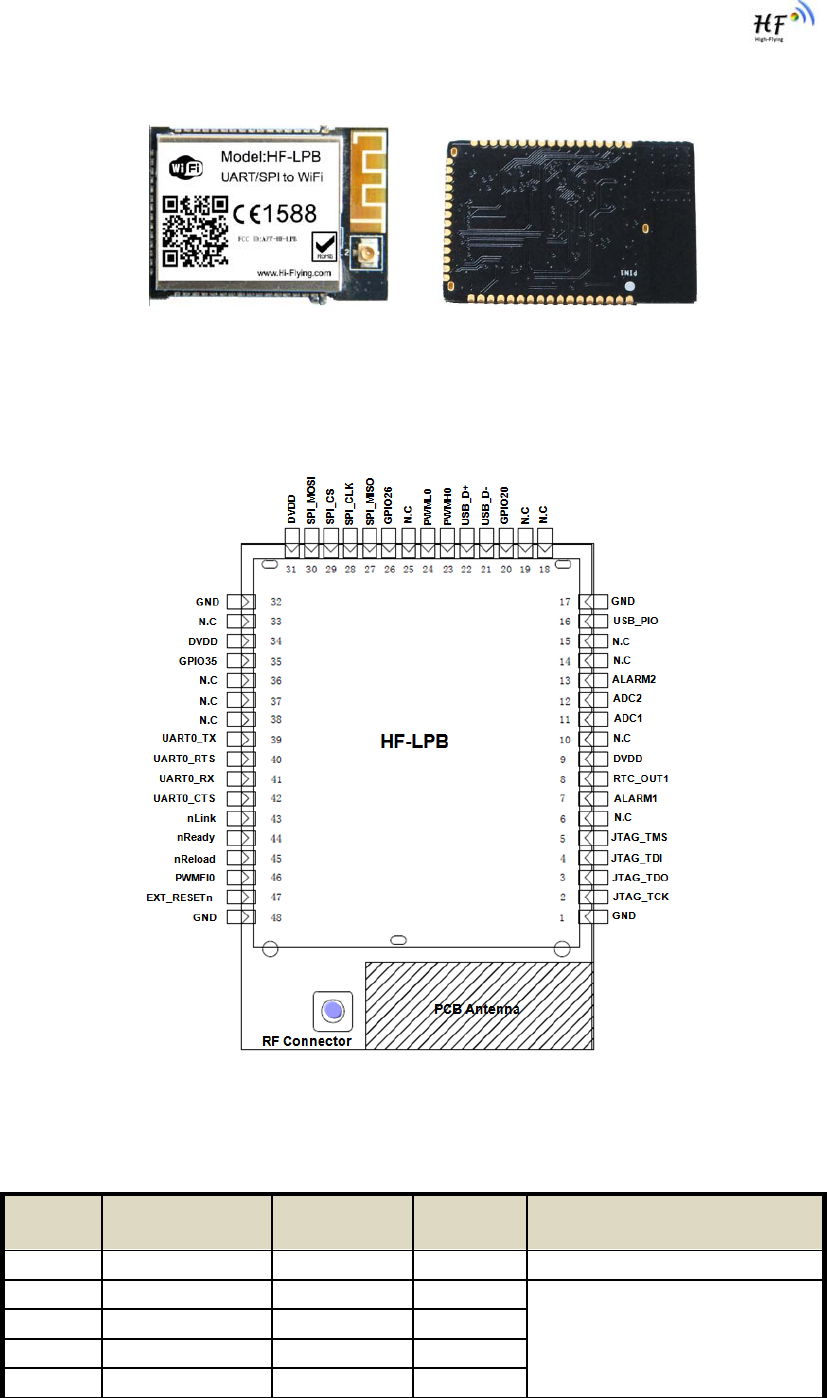
HF-LPB Low Power WiFi Module User Manual
Shanghai High-Flying Electronics Technology Co., Ltd
www.hi-flying.com
- 10 -
1.2. Hardware Introduction
Figure 1. HF-LPB Demo
1.2.1. Pins Definition
Figure 2. HF-LPB Pins Map
Table 2 HF-LPB Pins Definition
Pin Describtion Net Name Signal
Type Comments
1,17,32,48 Ground GND Power
2 JTAG Function JTAG_TCK I, PU JTAG/Debug functional pin,
No connect if not use.
3 JTAG Function JTAG_TDO O
4 JTAG Function JTAG_TDI I,PU
5 JTAG Function JTAG_TMS I,PU
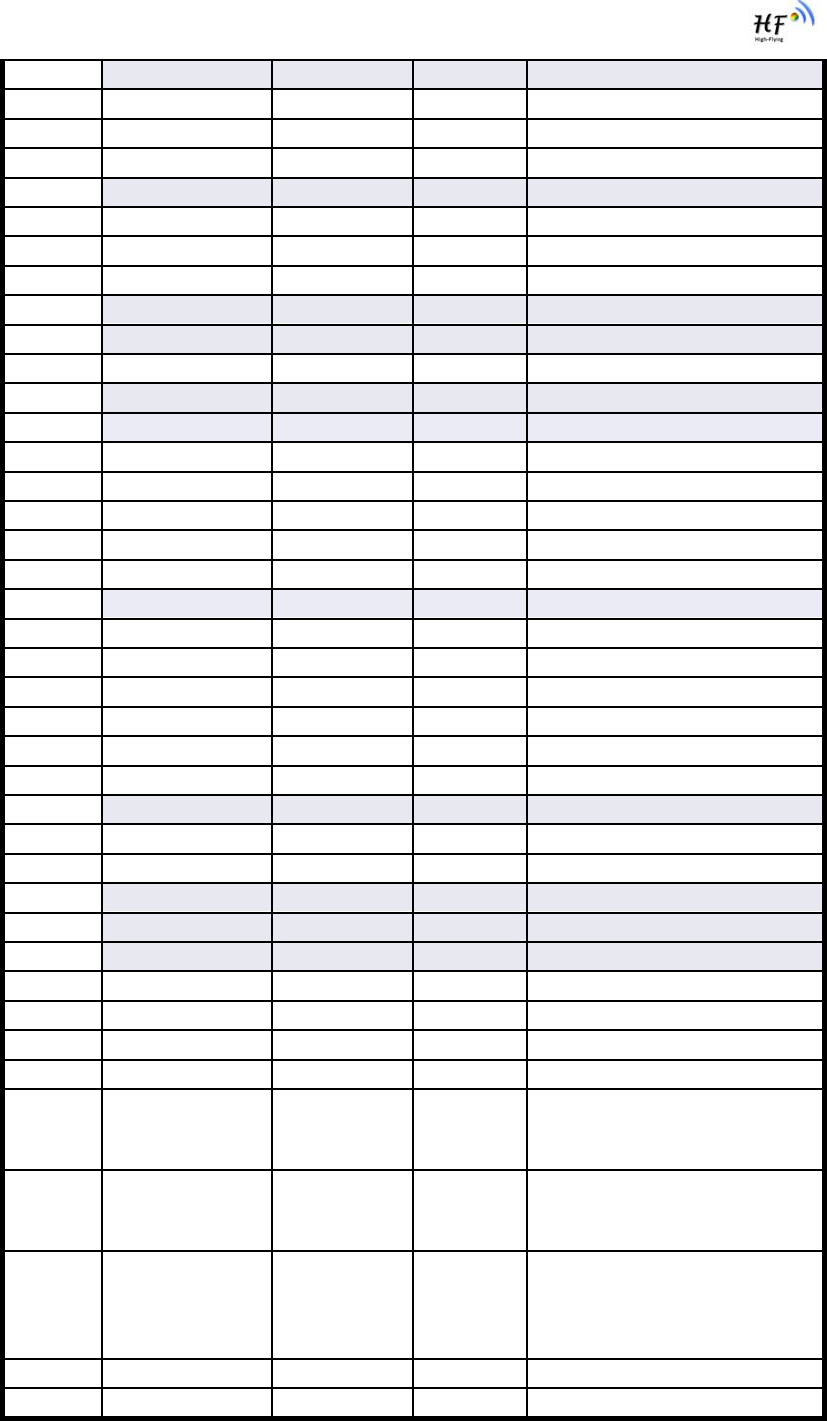
HF-LPB Low Power WiFi Module User Manual
Shanghai High-Flying Electronics Technology Co., Ltd
www.hi-flying.com
- 11 -
6 N.C No connect
7 RTC Input 1 ALARM1 I.PD GPIO7, Sleep_RQ Pin
8 RTC Output 1 RTC_OUT1 O GPIO8, Sleep_ON Pin
9 +3.3V Power DVDD Power
10 N.C No connect
11 A/D Input 1 ADC1 I/O,PD GPIO11, No connect if not use.
12 A/D Input 2 ADC2 I/O,PD GPIO12, No connect if not use.
13 RTC Input 2 ALARM2 I,PD GPIO13, No connect if not use.
14 N.C No connect
15 N.C No connect
16 USB 5V Detect USB_PIO I/O GPIO16, No connect if not use.
18 N.C No connect
19 N.C No connect
20 GPIO GPIO20 I/O,PD GPIO20, No connect if not use.
21 USB Interface USB- I/O 90 ohm Diff. Line
22 USB Interface USB+ I/O 90 ohm Diff. Line
23 PWM Output0+ PWMH0 O GPIO23, No connect if not use.
24 PWM Output0- PWML0 O GPIO24, No connect if not use.
25 N.C No connect
26 GPIO GPIO26 I/O,PD GPIO26, No connect if not use.
27 SPI Interface SPI_MISO I/O, PU No connect if not use.
28 SPI Interface SPI_CLK I/O, PU No connect if not use.
29 SPI Interface SPI_CS I/O,PU No connect if not use.
30 SPI Interface SPI_MOSI I/O.PD No connect if not use.
31 +3.3V Power DVDD Power
33 N.C No connect
34 +3.3 Power DVDD Power
35 GPIO GPIO35 I/O,PD GPIO35, WPS functional pin
36 N.C No connect
37 N.C No connect
38 N.C No connect
39 UART0 UART0_TX O, PD UART Communication Pin
40 UART0 UART0_RTS I/O,PD UART Communication Pin
41 UART0 UART0_RX I,PD UART Communication Pin
42 UART0 UART0_CTS I/O, PD UART Communication Pin
43 Wi-Fi Status nLink O,PU “0”- Wi-Fi Linked
“1”- No WIFI Linked
No connect if not use.
44 Module Boot Up
Indicator
nReady O,PU “0” – Boot-up OK;
“1” – Boot-up No OK;
No connect if not use.;
45 Restore
Configuration
nReload I,PU Module will restore factory
default after set this pin “0” more
than 1s, then set “1”.
No connect if not use;
46 PWM Fault Input0 PWMFI0 GPIO46, No connect if not use.
47 Module Reset EXT_RESETn I,PU “Low” effective reset input.
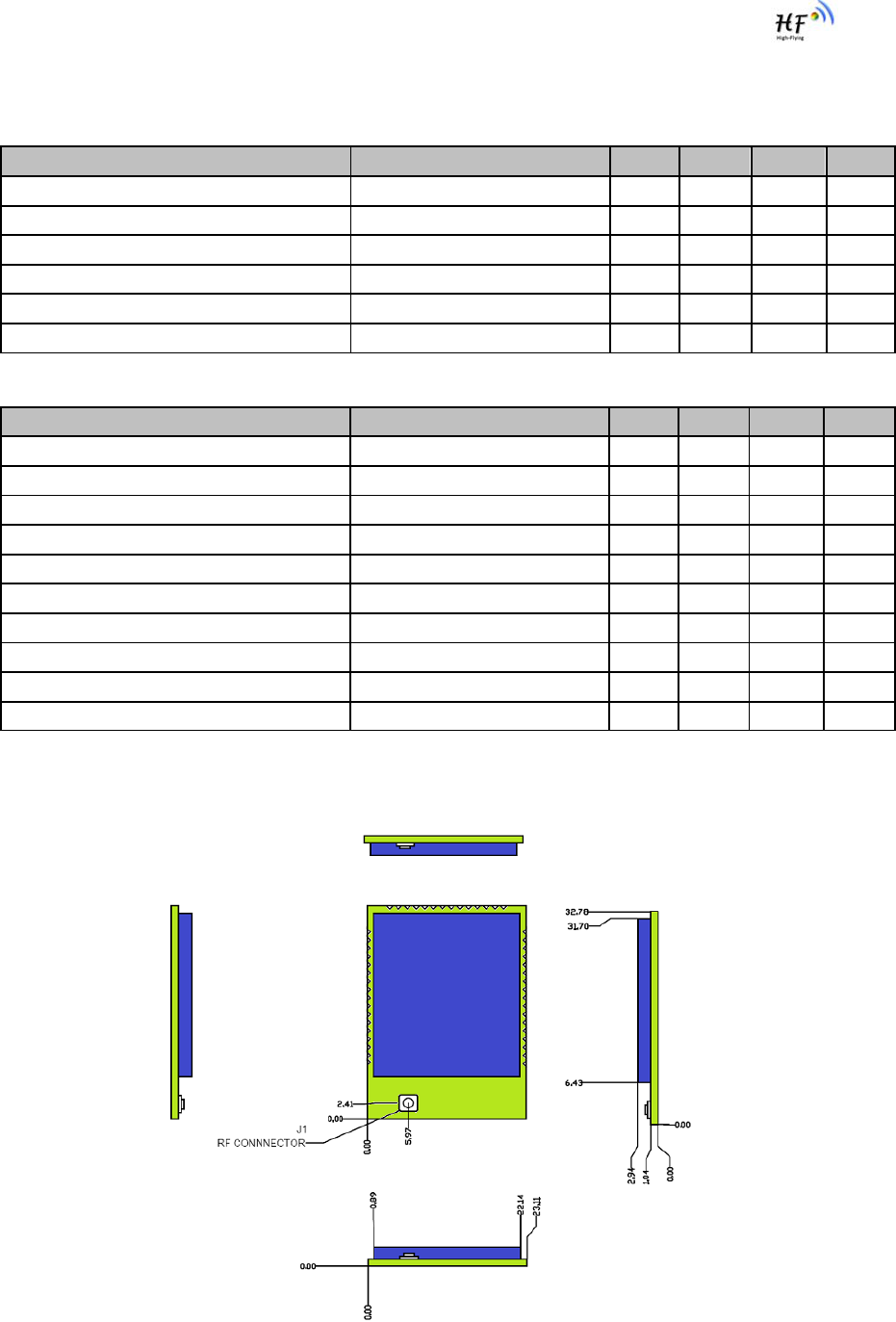
HF-LPB Low Power WiFi Module User Manual
Shanghai High-Flying Electronics Technology Co., Ltd
www.hi-flying.com
- 12 -
1.2.2. Electrical Characteristics
Absolute Maximum Ratings:
Parameter Condition Min. Typ. Max. Unit
Storage temperature range -45 125 °C
Maximum soldering temperature IPC/JEDEC J-STD-020 260 °C
Supply voltage 0 3.8 V
Voltage on any I/O pin 0 3.3 V
ESD (Human Body Model HBM) TAMB=25°C 2 KV
ESD (Charged Device Model, CDM) TAMB=25°C 1 KV
Power Supply & Power Consumption:
Parameter Condition Min. Typ. Max. Unit
Operating Supply voltage 3.1 3.3 3.8 V
Supply current, peak Continuous Tx 200 mA
Supply current, IEEE PS DTIM=100ms 5 mA
Output high voltage Sourcing 6mA 2.8 V
Output low voltage Sinking 6mA 0.2 V
Input high voltage 2.2 V
Input low voltage 0.8 V
Input leakage current +/-25 nA
Analog input range 0 3 V
Analog output range 0 3 V
1.2.3. Mechanical Size
HF-LPB modules physical size (Unit: mm) as follows:
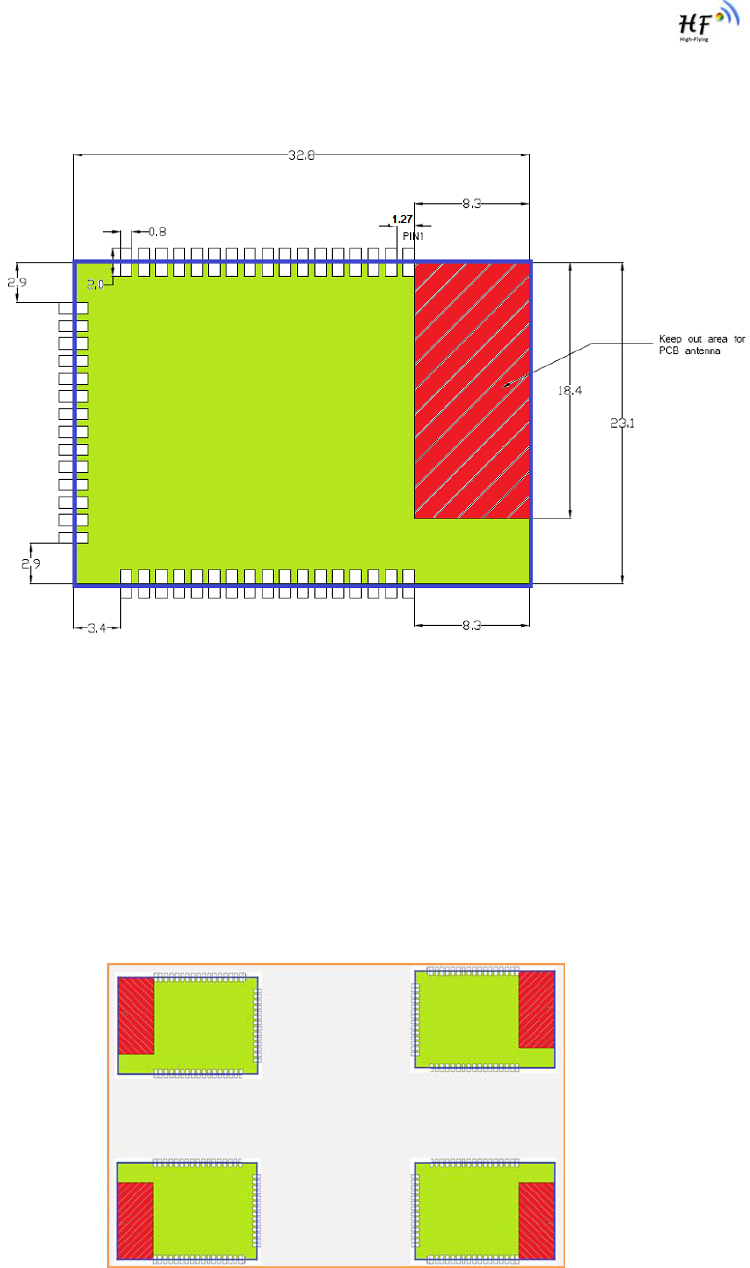
HF-LPB Low Power WiFi Module User Manual
Shanghai High-Flying Electronics Technology Co., Ltd
www.hi-flying.com
- 13 -
Figure 3. HF-LPB Mechanical Dimension
HF-LPB Module PCB symbol size (mm) as follows:
Figure 4. HF-LPB PCB Symbol Size
1.2.4. On-board Chip Antenna
HF-LPB module support internal on-board chip antenna option. When customer select internal
antenna, you shall comply with following antenna design rules and module location suggestions:
¾ For customer PCB, RED color region (8.3x18.4mm) can’t put componet or paste GND net;
¾ Antenna must away from metal or high components at least 10mm;
¾ Antenna can’t be shieldedby any meal enclosure; All cover, include plastic, shall away from
antenna at least 10mm;
Figure 5. Suggested Module Placement Region
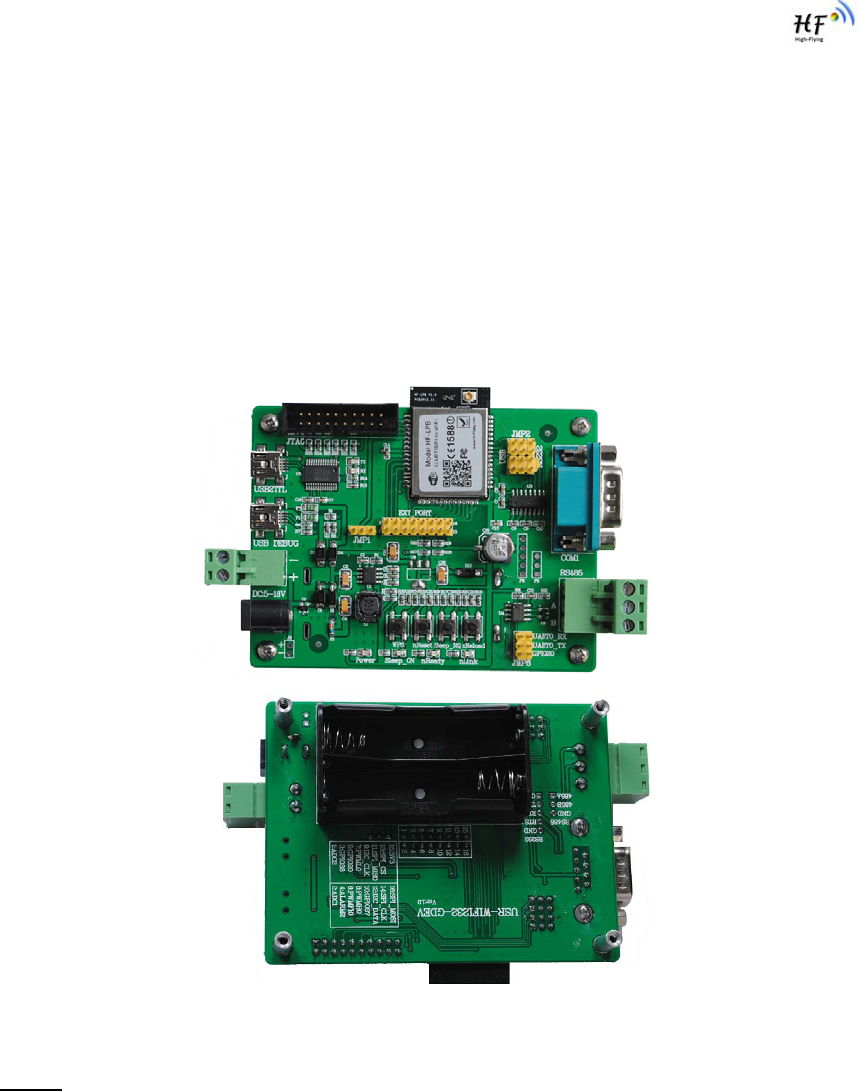
HF-LPB Low Power WiFi Module User Manual
Shanghai High-Flying Electronics Technology Co., Ltd
www.hi-flying.com
- 14 -
High-Flying suggest HF-LPB module better locate in following region at customer board, which to
reduce the effect to antenna and wireless signal, and better consult High-Flying technical people when
you structure your module placement and PCB layout.
1.2.5. Evaluation Kit
High-Flying provides the evaluation kit to promote user to familiar the product and develop the detailed
application. The evaluation kit shown as below, user can connect to HF-LPB module with the RS-232
UART, RS485, USB (Internal UART-USB convetor) or Wireless port to configure the parameters,
manage the module or do the some functional tests.
Figure 6. HF-LPB Evaluation Kit
Notes: User need download USB - UART port driver from High-Flying web or contact with technical
support people for more detail.
The external interface description for evaluation kit as follows:
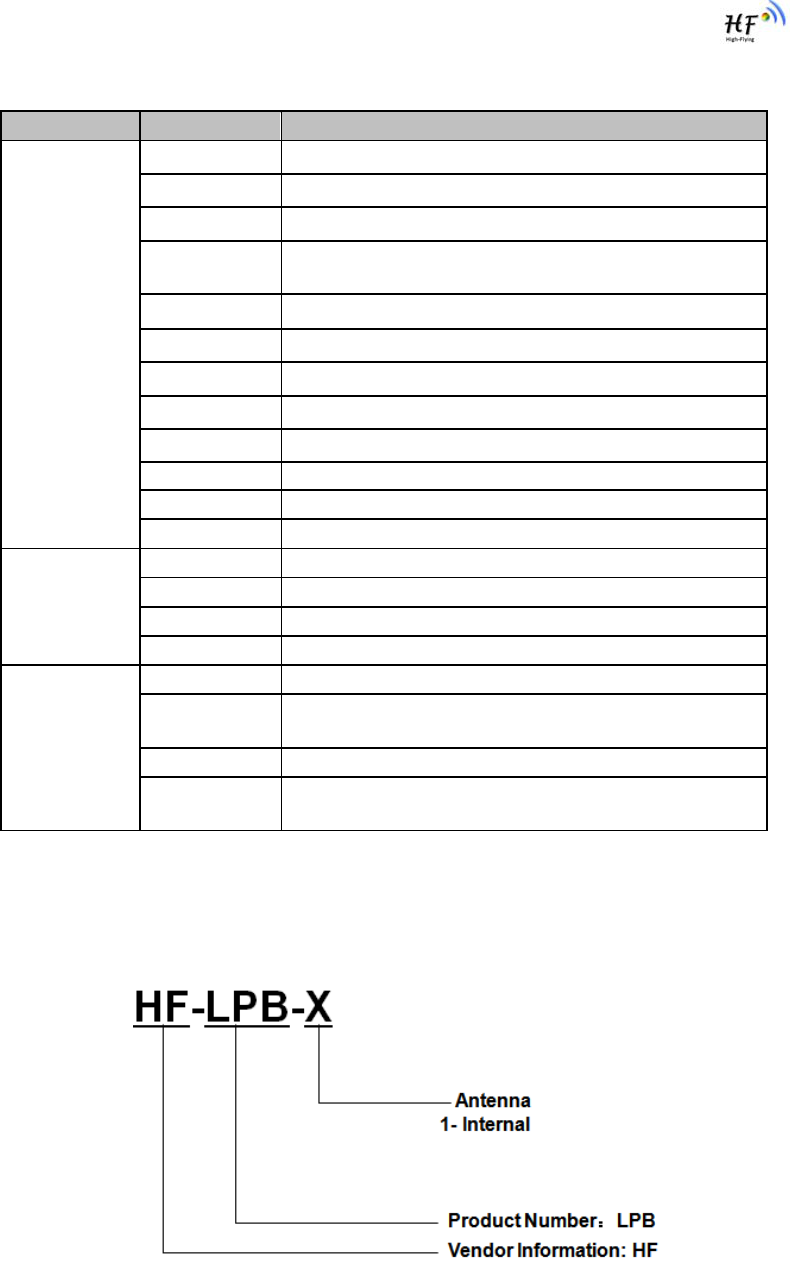
HF-LPB Low Power WiFi Module User Manual
Shanghai High-Flying Electronics Technology Co., Ltd
www.hi-flying.com
- 15 -
Table 4 HF-LPB Evaluation Kit Interface Description
1.2.6. Order Information
Base on customer detailed requirement, HF-LPB series modules provide different variants and
physical type for detailed application.
Figure 7. HF-LPB Order Information
Function Name Description
External
Interface COM1 Main data/command RS-232 interface
RS485 Main data/command RS-485 interface
JTAG JTAG data debug interface (Not for user use)
USB2TTL UART to USB debug interface. (For PC without
RS232, need load driver). Can be Power input.
USB DEBUG USB2.0 data interface.
DC Jack DC jack for power in, 5~18V input.
DC5-18V DC jack for power in, 5~18V input.
BAT 2 Li-Battery Power Supply.
EXT PORT HF-LPB GPIO function extend interface connector
JMP1,JMP2 Reserved, No Jumper required.
JMP3 4Pin USB or RS232 Jumper. Left jump select USB.
JMP6 3Pin RS485 Jumper. No jump selects RS232.
LED Power 3.3V Power Indicator
nLink nLink -WiFi LINK Indicator
nReady nReady – Module Bootup Ready Indicator
Sleep_ON Sleep_ON-Module asleep or awake Indicator
Button nReset Used to reset the module.
nReload Restore factory default configuration after push this
pin more than 3s.
WPS WPS Button
Sleep_RQ Pin Sleep Control button, more than 1s to put
module in standby mode.
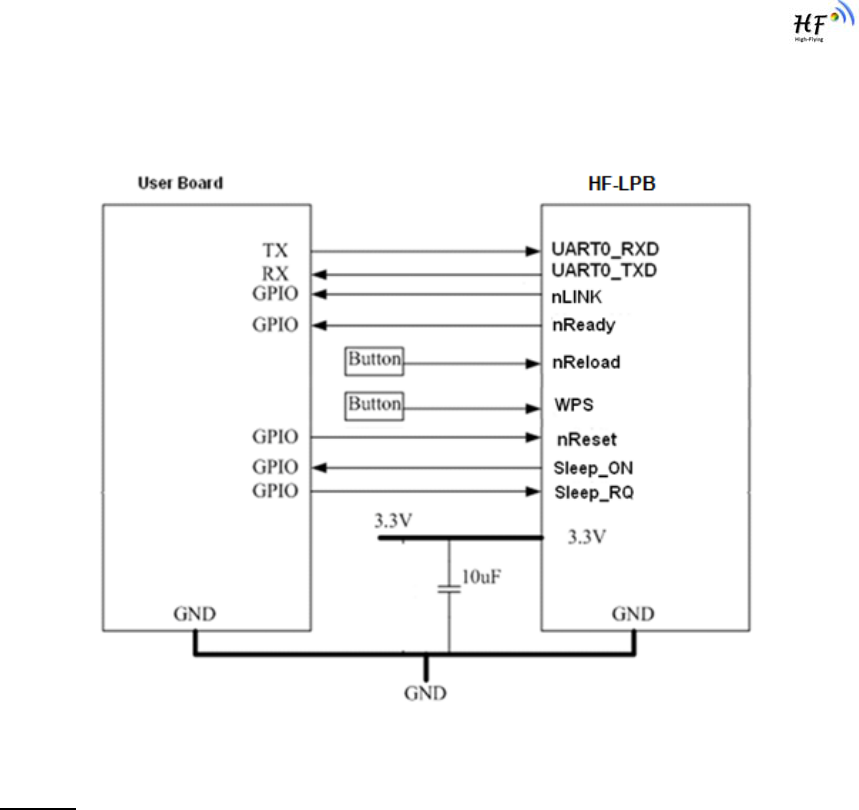
HF-LPB Low Power WiFi Module User Manual
Shanghai High-Flying Electronics Technology Co., Ltd
www.hi-flying.com
- 16 -
1.3. Typical Application
1.3.1. Hardware Typical Application
Figure 8. HF-LPB Hardware Typical Application
Notes:
nReset- Module hardware reset signal. Input. Logics “0” effective.
There is pull-up resister internal and no external pull-up required. When module power up or some
issue happened, MCU need assert nRST signal “0” at least 10ms, then set” 1” to keep module fully
reset.
nLink- Module WIFI connection status indication. Output.
When module connects to AP (AP associated), this pin will output “0”. This signal used to judge if
module already at WiFi connection status. Thers is pull-up resister internal and no external pull-up
required. If n Link function not required, can leave this pin open.
nReady- Module boot up ready signal. Output. Logics “0” effective.
The module will output “0” after normal boot up. This signal used to judge if module finish boot up and
ready for application or working at normal mode. If nReady function not required, can leave this pin
open.
WPS – module auto-negotiation with AP and acquire password and build link
User can de-asser this pin low ”0”, after 500ms, then asser this pin high “1” to enable the auto
negotiation.if AP also push its WPS button, then Module and AP will start auto-negotiation and

HF-LPB Low Power WiFi Module User Manual
Shanghai High-Flying Electronics Technology Co., Ltd
www.hi-flying.com
- 17 -
module acquire password and build link. Next time, module will link with same AP without auto-
negotiation required. User can use “AT+WSSSID” and “AT+WSKEY” command to query SSID and
password.
nReload- Module restore to factory default configuration.Input. Logics “0” effective.
User can de-assert nReload signal “0” more than 3s through button or MCU pin, then release, module
will restore to factory default configuration and re-start boot up process. Thers is pull-up resister
internal and no external pull-up required. If nReload function not required, can leave this pin open.
Sleep-RQ- Module Pin Sleep Control. Input.
The user should de-assert this pin low “0”, after 1’s assert to high ”1” to put the module to sleep status.
Also at the deep sleep/standby mode, user can de-assert this pin low “0”, after 1’s assert to high ”1”
to put the module to wake up the module. If user doesn't use pin sleep function, can leave this pin
open.
Sleep-ON- Module Pin Sleep Indicator. Output.
This pin is used to indicate that the module is asleep (Module output “0”) or awake (Module output “1”)
status. If user doesn't use pin sleep function, can leave this pin open.
UART0_TXD/RXD- UART port data transmit and receive signal.
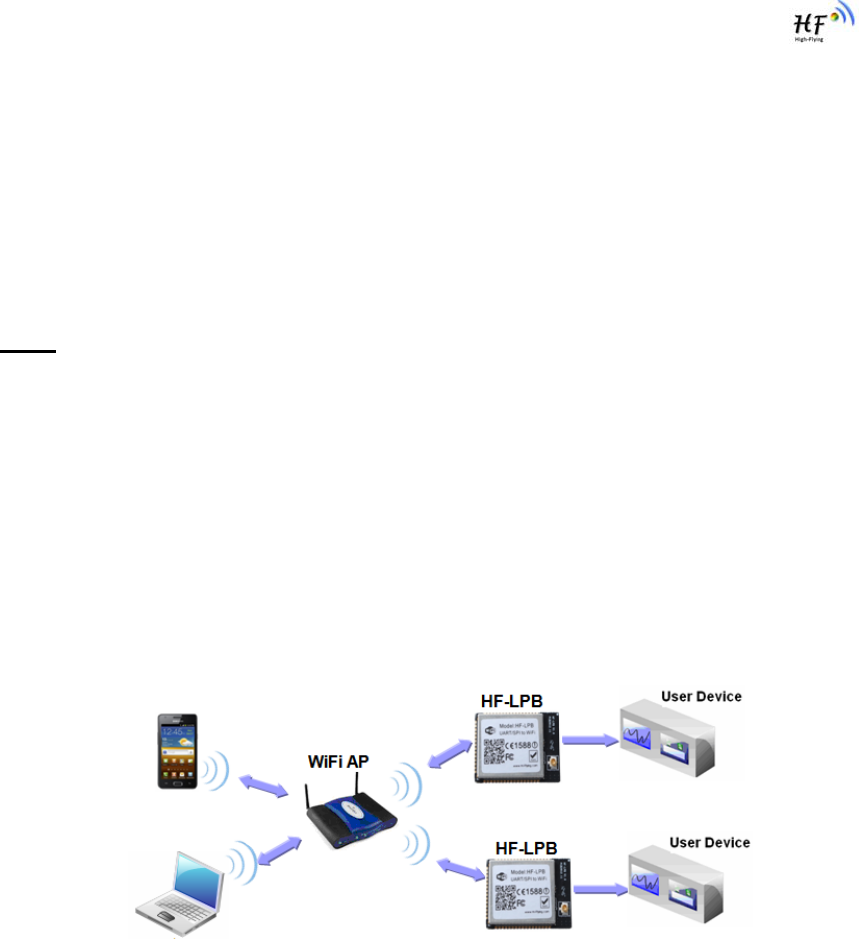
HF-LPB Low Power WiFi Module User Manual
Shanghai High-Flying Electronics Technology Co., Ltd
www.hi-flying.com
- 18 -
2. FUNCTIONAL DESCRIPTION
2.1. Wireless Networking
HF-LPB module can be configured as both wireless STA and AP base on network type. Logically
there are two interfaces in HF-LPB. One is for STA, and another is for AP. When HF-LPB works as AP,
other STA equipments are able to connect to wireless LAN via HF-LPB module. Wireless Networking
with HF-LPB is very flexible.
Notes:
AP: that is the wireless Access Point, the founder of a wireless network and the centre of the network
nodes. The wireless router we use at home or in office may be an AP.
STA: short for Station, each terminal connects to a wireless network (such as laptops, PDA and other
networking devices) can be called with a STA device.
2.1.1. Basic Wireless Network Based On AP (Infrastructure)
Infrastructure: it’s also called basic network. It built by AP and many STAs which join in.
The characters of network of this type are that AP is the centre, and all communication between STAs
is transmitted through the AP. The figure following shows such type of networking.
Figure 9. HF-LPB Basic Wireless Network Structure
2.1.2. Wireless Network Based On AP+STA
HF-LPB module support AP+STA network mode, means module support one AP interface and one
STA interface at the same time, as following figure,
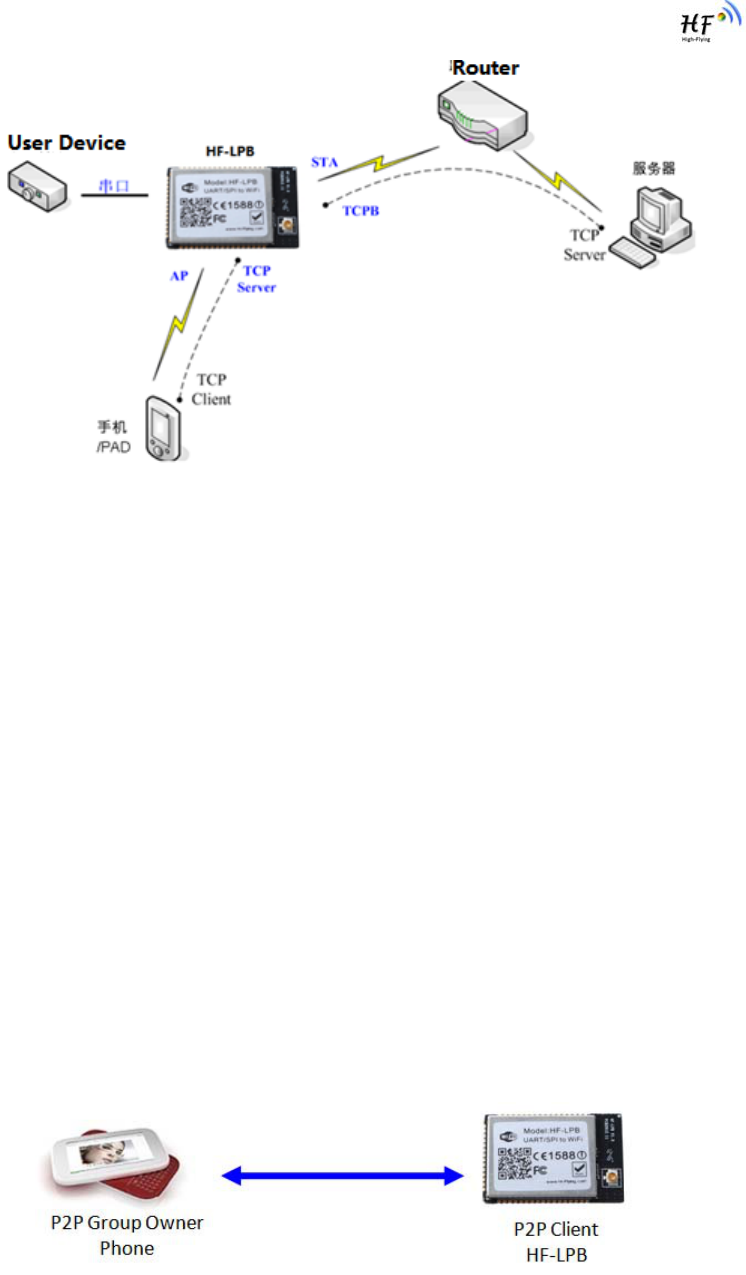
HF-LPB Low Power WiFi Module User Manual
Shanghai High-Flying Electronics Technology Co., Ltd
www.hi-flying.com
- 19 -
Figure 10. HF-A11 AP+STA Network Structure
When module enables AP+STA function, Module’s STA interface can connect with router and connect
to TCP server in the network. At the same time, module’s AP interface is also active and permit
phone/PAD to connect through TCPB, then phone/PAD can control user device and and setting the
module parameters,
The advantage of AP+STA mode is:
¾ Users can easily setting and track user device through Phone/PAD and not change the
orginal network setting.
¾ Users can easily setting module’s parameters through WiFi when module works as STA
mode.
2.1.3. Wi-Fi Direct Network
Wi-Fi Direct standard permits the wireless connection without AP router. Like blue tooth, this standard
use point to point interconnection and all devices connect each other and transmit data withour router.
HF-LPB module support following Wi-Fi Direct networking:
¾ 1:1 P2P Networking;
¾ 1:N P2P Networking;
¾ Concurrent Operation Networking;
Figure 11. HF-LPB 1:1 P2P Networking
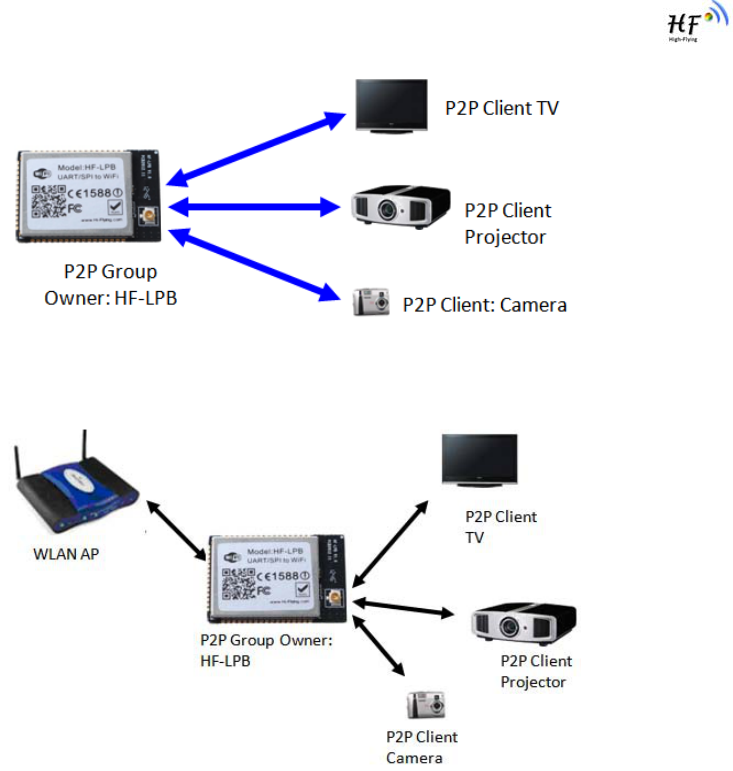
HF-LPB Low Power WiFi Module User Manual
Shanghai High-Flying Electronics Technology Co., Ltd
www.hi-flying.com
- 20 -
Figure 12. HF-LPB 1:N P2P Networking
Figure 13. HF-LPB Concurrent Operation Networking
2.2. Work Mode : Transparent Transmission Mode
HF-LPB module support serial interface transparent transmission mode. The benefit of this mode is
achieves a plug and play serial data port, and reduces user complexity furthest. In this mode, user
should only configure the necessary parameters. After power on, module can automatically connect to
the default wireless network and server.
As in this mode, the module's serial port always work in the transparent transmission mode, so users
only need to think of it as a virtual serial cable, and send and receive data as using a simple serial. In
other words, the serial cable of users’ original serial devices is directly replaced with the module; user
devices can be easy for wireless data transmission without any changes.
The transparent transmission mode can fully compatible with user’s original software platform and
reduce the software development effort for integrate wireless data transmission.
The parameters which need to configure include:
¾ Wireless Network Parameters
Wireless Network Name(SSID)
Security Mode

HF-LPB Low Power WiFi Module User Manual
Shanghai High-Flying Electronics Technology Co., Ltd
www.hi-flying.com
- 21 -
Encryption Key
¾ TCP/UDP Linking Parameters
Protocol Type
Link Type(Server or Client)
Target Port ID Number
Target Port IP Address
¾ Serial Port Parameters
Baud Rate
Data Bit
Parity (Check) Bit
Stop Bit
Hardware Flow Control
2.3. UART Frame Scheme
2.3.1. UART Free-Frame
HF-LPB support UART free-frame function. If user select open this function, module will check the
intervals between any two bytes when reciving UART data. If this interval time exceeds defined value
(50ms default), HF-LPB will think it as the end of one frame and transfer this free-frame to WiFi port,
or HF-LPB will receive UART data untill 1400 bytes, then transfer 1400 bytes frame to WiFi port.
HF-LPB’s default interval time is 50ms. User can also set this interval to fast (10ms) through AT
command. But user have to consider if user MCU can send UART data with 10ms interval ,or the
UART data may be divide as fragment.
Through AT command: AT+UARTTE=fash/normal, user can set the interval time: fast (10ms) and
normal (50ms).
2.3.2. UART Auto-Frame
HF-LPB support UART auto-frame function. If user select open this function and setting auto-frame
trigger length and auto-frame trigger time parameters, then module will auto framing the data which
received from UART port and transmitting to the network as pre-defined data structure.
¾ Auto-frame trigger length: The fixed data length that module used to transmitting to the
network.
¾ Auto-frame trigger time: After the trigger time, if UART port received data can’t reach auto-
frame trigger length, then module will transmitting available data to the network and bypass
the auto-frame trigger length condition.
Detailed UART auto-frame function can refer to AT+ instruction set “UARTF/UARTFT/UARTFL”
introduction.

HF-LPB Low Power WiFi Module User Manual
Shanghai High-Flying Electronics Technology Co., Ltd
www.hi-flying.com
- 22 -
2.4. Encryption
Encryption is a method of scrambling a message that makes it unreadable to unwanted parties,
adding a degree of secure communications. There are different protocols for providing encryption, and
the HF-LPB module supports following:
WEP
WPA-PSK/TKIP
WPA-PSK/AES
WPA2-PSK/TKIP
WPA2-PSK/AES
2.5. Network Protocal
HF-LPB includes a fully IPv4 and IPv6 capable stack supporting TCP and UDP connection.Following
table shows the key features of the HF-LPB module IP stack, which including support for DHCP,
multicast, and ARP.
The Frame size limits are (including IP headers):
z Tranmit
9 TCP/UDP/ICMP (v4): 1576
9 ICMP (v6): 1576
9 UCP/UDP (v6): 1220
z Receive
9 TCP/UDP (v4): 1516
9 TCP/UDP (v6): 1496
9 ICMPv4 and ICMPv6: 5000
Table 5 HF-LPB IP Stack Features
Feature Support
ARP Supported
Forwarding Supported
Fragmentation/Reassembly Planned
IPv4/v6 Header Processing Supported
UDP/TCP Socket Support Supported
DHCP v4 Supported
Neighbor Discovery Supported
Broadcast/Multicast Supported
Path MTU Discovery Supported
Address Auto-Configuration Supported
Multicast Planned
TCP Zero Copy Feature Supported
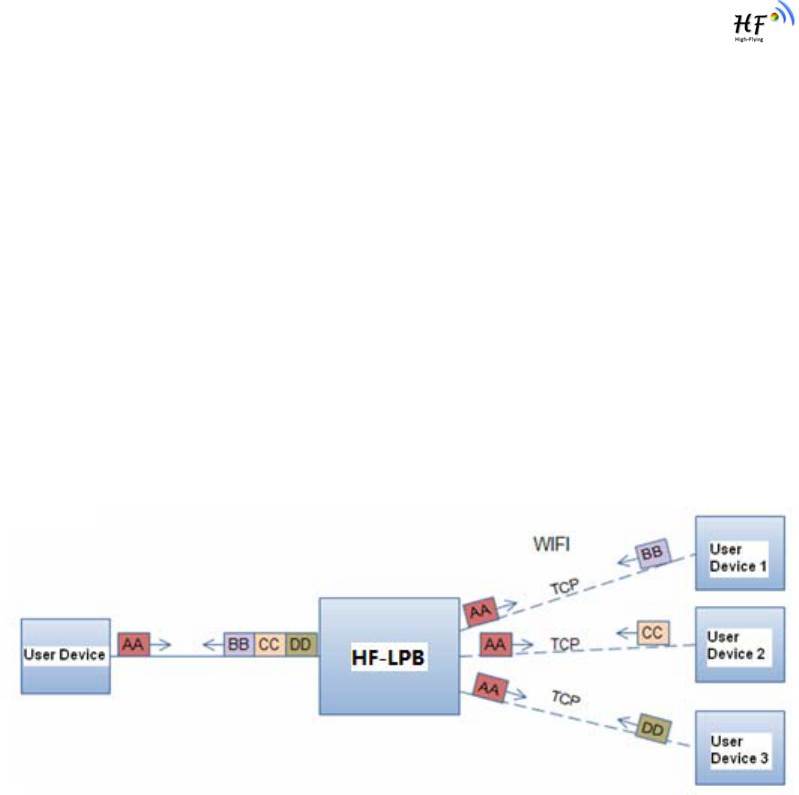
HF-LPB Low Power WiFi Module User Manual
Shanghai High-Flying Electronics Technology Co., Ltd
www.hi-flying.com
- 23 -
2.6. Multi-TCP Link Connection
When HF-LPB module configured as TCP Server, it supports Multi-TCP link connection, and
maximum eight TCP clients permit to connect to HF-LPB module. User can realize multi-TCP link
connection at each work mode.
Multi-TCP link connection will work as following structure:
Upstream:
All dates from different TCP connection or client will be transmitted to the serial port as a sequence.
Downstream:
All data from serial port (user) will be duplicate and broadcast to every TCP connection or client.
Detailed multi-TCP link data transmition structure as following figure:
Figure 14. Multi-TCP Link Data Transmition Structure
2.7. Power Save Scheme
HF-LPB module can work at three modes based on different power save scheme:
Normal (Active/Sleep) Mode - AP Associated, WiFi ON/OFF based on internal control
Deep Sleep Mode - Non AP Associated, WiFi OFF
Standby Mode - Non AP Associated, WiFi Shut dwon
Normal (Active/Sleep) Mode Normal mode support two work option: One is no DTIM related (Default
mode), module will monitor the interval to Active/Sleep. The other is DTIM related mode, whcih allows
the module to sync up with beacons sent from the AP which contains the DTIM (Delivery Traffic
Indication Message). The DTIM indicates when broadcast and multicast data will be sent on the
network. This property is configured on the AP (Default value is 1, which means DTIM= 100ms) and is
typically configured as the number of beacons between each beacon with DTIM.
Deep Sleep/Standby Mode allows the WiFi circuitry to be “OFF” status or powered down, which
results in the lower/lowest sleep current, but at the expense of longer wake up times. This is due to
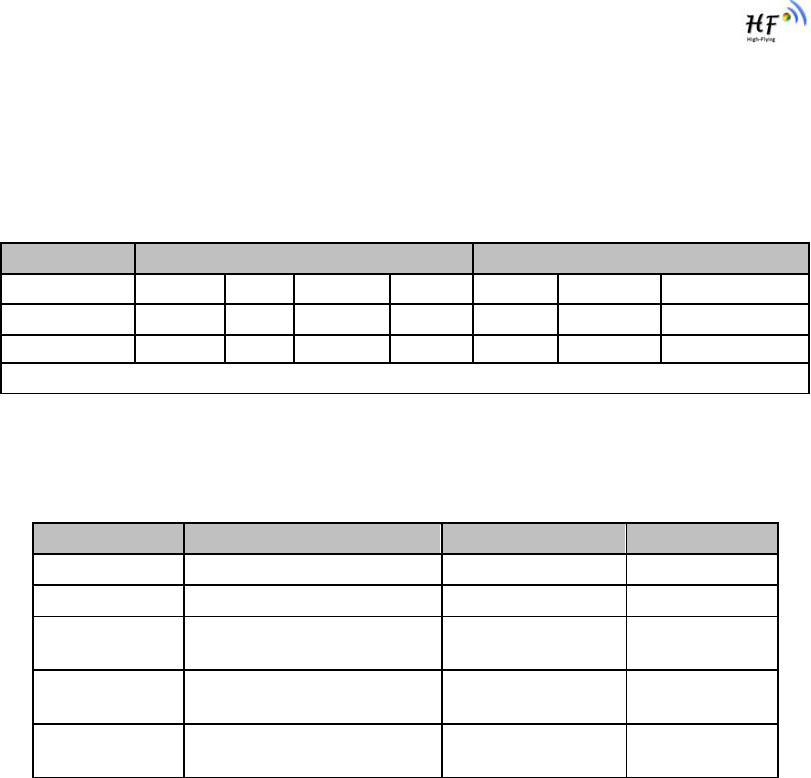
HF-LPB Low Power WiFi Module User Manual
Shanghai High-Flying Electronics Technology Co., Ltd
www.hi-flying.com
- 24 -
the module associating with the access point every time when it wakes up. The intent of this option is
to allow for longer sleep times.
The Difference between deelp sleep and standby mode as follows:
Table 6 Difference Between Deelp Sleep And Standby Mode
Status Wake Up Method
Wi-Fi MCU Current UART GPIO Timeout AT Commond
Deep Sleep OFF ON ~2mA ON Yes Yes Yes
Standby OFF OFF <2uA OFF Yes Yes No
Notes: For GPIO wake up, if trigger time <1s, then only wake up MCU.
Following typical measurement parameters can be used for select suitable power save scheme based
on the real application case:
Table 7 Power Consumption with Different Power Save Mode
WiFi Mode Condition Average Current Peak Current
Standby WiFi Shutdown ~2uA < 10uA
Deep Sleep WiFi OFF ~2mA < 10mA
Normal
(Active/Sleep)
WiFi ON - AP Connected
DTIM = 100ms
5.5~7mA < 220mA
Normal
(Active/Sleep)
WiFi ON – AP Connected
DTIM = 500ms
3.5mA < 220mA
Normal
(Active/Sleep)
WiFi ON – AP Connected
DTIM = 1000ms
2.8mA < 220mA
In addition, for deep sleep/standby mode, module provides three wakes up options, user can select
one or whole as the module wake up option. Refer to AT Instruction (Power Management Instruction
Set) for more detailed setting.
Pin Wake Up
UART Wake Up
Timeout Wake Up
Pin Wake Up Option allows an external microcontroller to determine when HF-LPB should sleep and
when it should wake by controlling the “Sleep_RQ” and “Sleep_ON” pin. at the deep sleep/standby
mode, user can de-assert this pin low “0”, after 1’s assert to high ”1” to put the module to wake up the
module. If user doesn't use pin sleep function, can leave this pin open.
UART Wake Up Option. HF-LPB can use AT command to put module into normal/sleep mode. When
module works at deep sleep or standby mode, user can use ”AT+MSLP =normal” to wake up module.
Timeout Wake Up Option allows the sleep timeout period to be configured through the use of AT
Instruction.In this option, the module will exit sleep based on the <Timeout> AT Instruction parameters

HF-LPB Low Power WiFi Module User Manual
Shanghai High-Flying Electronics Technology Co., Ltd
www.hi-flying.com
- 25 -
2.8. Parameters Configuration
HF-LPB module supports two methods to configuration parameters: Web Accessing and
AT+instruction set.
Web accessing means users can configure parameters through Web browser. When HF-LPB module
connected to wireless network, parameters configuration is done on a PC connected to the same
wireless network.
AT+instruction set configuration means user configure parameters through serial interface command.
Refer to “AT+instruction set” chapter for more detail.
2.9. Firmware Update
HF-LPB module supports two on-line upgrade methods:
Webpage Wi-Fi Upgrade
Remote Upgrade
Webpaged based Wi-Fiupgrade,please refer to 3.1.8 firmware upgrade page , user can upload
firmware file from PC to HF-LPB.
Remote upgrade: TBD
Notes: please contact with high-flying technical people before upgrade firmware, or maybe damage
the module and can’t work again.
2.10. GPIO Function
HF-LPB module can provide maximum 12 GPIO pins, which include 2 A/D analog input pins, 3 PWM
control pins, 2 Pin sleep control pins, 1 WPS pin, 1 RTC pin, 1 USB 5V control pin, and 2 general
GPIO pin. All these pins can be customized as GPIO pins if these functions are not required. As GPIO
functional pin, user devices can read/write GPIO pins status through AT+instruction set.
Table 8 HF-LPB GPIO Pin Mapping Table
When module works at GPIO mode, PC and other equipts can setup connection (TCP/UDP) through
WiFi, then read/write GPIO information through command.
GPIO Configured Function Describtion Default Setting Type
GPIO7 Sleep_RQ Wakeup/Sleep Sleep_RQ I,PD
GPIO8 Sleep_ON Sleep_ON O
GPIO11 A/D Input 1 A/D GPIO11 I/O,PD
GPIO12 A/D Input 2 GPIO12 I/O,PD
GPIO13 RTC Input 2 RTC GPIO13 I,PD
GPIO16 USB 5V Track USB GPIO16 I/O
GPIO20 GPIO GPIO GPIO20 I/O
GPIO23 PWM Dif. Out+ PWM GPIO23 O
GPIO24 PWM Dif. Out- GPIO24 O
GPIO26 GPIO GPIO GPIO26 I/O
GPIO35 WPS Input WPS GPIO35 I/O,PD
GPIO46 PWM Fault Input PWM GPIO46 I/O

HF-LPB Low Power WiFi Module User Manual
Shanghai High-Flying Electronics Technology Co., Ltd
www.hi-flying.com
- 26 -
¾ GPIO n IN, Set GPIOn as input, Response GPIO OK or GPIO NOK;
¾ GPIO n OUT 0, Set GPIOn as output and output ‘0’, Response GPIO OK or GPIO NOK;
¾ GPIO n OUT 1, Set GPIOn as output and output ‘1’, Response GPIO OK or GPIO NOK;
¾ GPIO n SW, Set GPIOn as output and switch the output status, Response GPIO OK or
GPIO NOK;
¾ GPIO n PWM m1 m2, Set GPIOn output a wave: m1 is ‘high’ duration and m2 is ’low’
duration (Time unit is ‘ms’ and minimal is 10ms), Response GPIO OK or GPIO NOK;
¾ GPIO n GET, Read GPIOn status, Response I0,I1,O0,O1, means”input low”,”input
high”,”output low”,”output high”
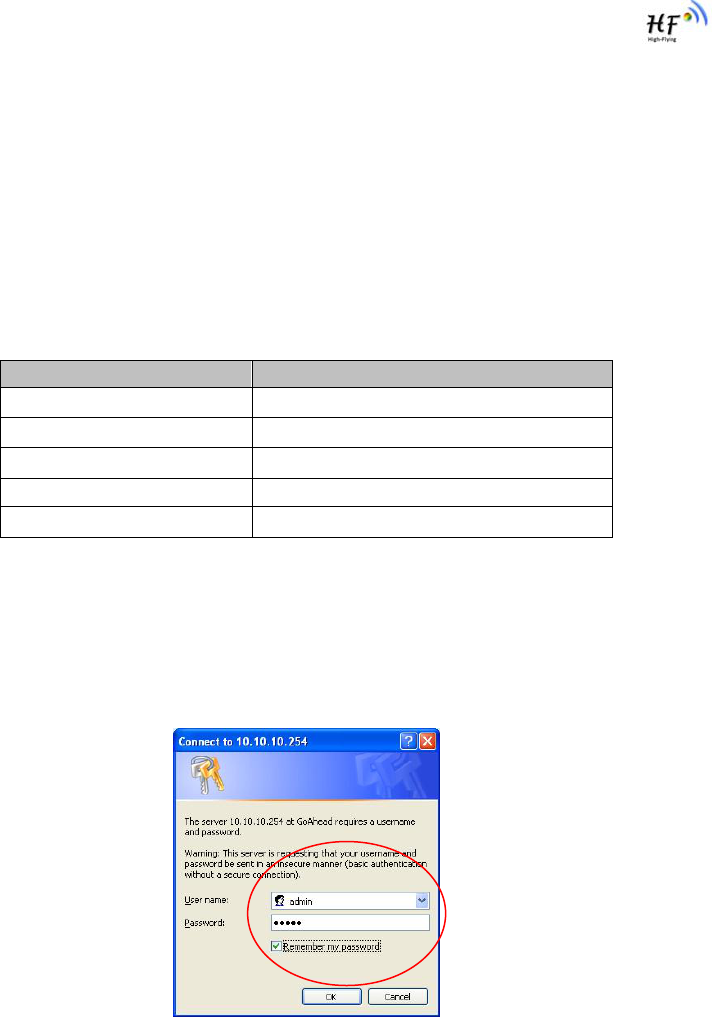
HF-LPB Low Power WiFi Module User Manual
Shanghai High-Flying Electronics Technology Co., Ltd
www.hi-flying.com
- 27 -
3. OPERATION GUIDELINE
3.1. Configuration via Web Accessing
When first use HF-LPB modules, user may need some configuration. User can connect to HF-LPB
module’s wireless interface with following default setting information and configure the module through
laptop.
Table 9 HF-LPB Web Access Default Setting
Parameters Default Setting
SSID HF-LPB
IP Address 10.10.100.254
Subnet Mask 255.255.255.0
User Name Admin
Password Admin
3.1.1. Open Web Management Interface
Step 1: Connect laptop to SSID “HF-LPB” of HF-LPB module via wireless LAN card;
Step 2: After wireless connection OK. Open Wen browser and access “http://10.10.100.254”;
Step 3: Then input user name and password in the page as following and click “OK” button.
Figure 15. Open Web Management page
The HF-LPB web management page support English and Chinese language. User can select
language environment at the top right corner and click “Apply” button.
The main menu include nine pages: “System”, “Work Mode”, “STA Setting”, “AP Setting”, “Other
Setting”, “Account”, “Upgrade SW”, “Restart”, “Restore”.
3.1.2. System Page
At this page, user can check current device’s important information and status such as: device ID
(MID), software version, wireless work mode and related Wi-Fi parameters.
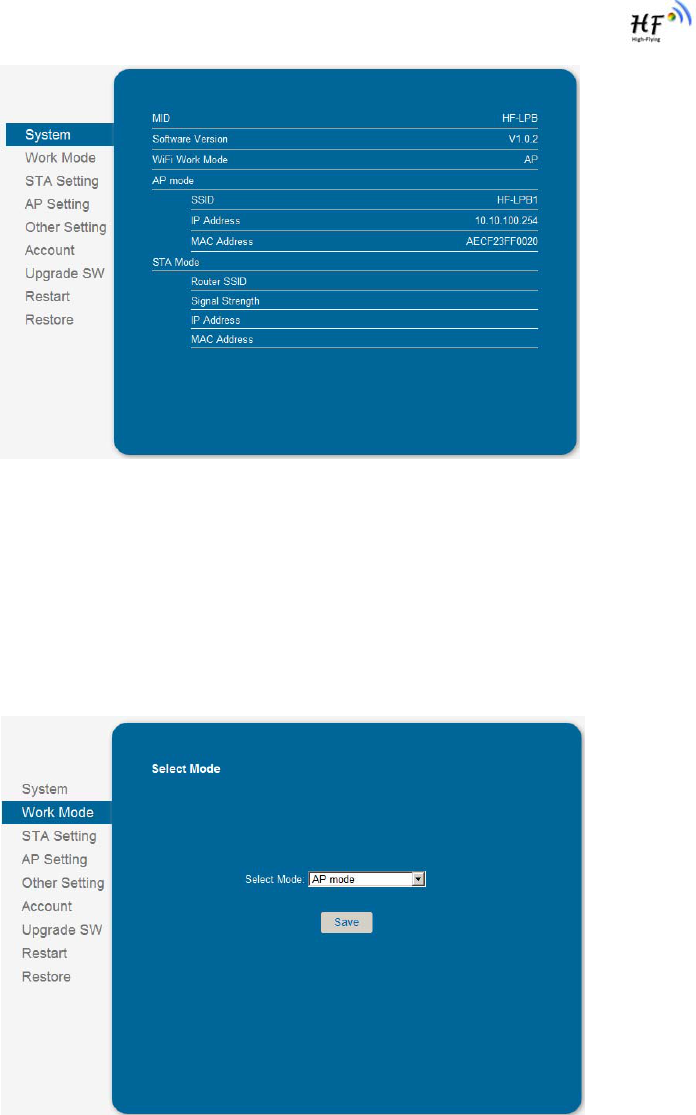
HF-LPB Low Power WiFi Module User Manual
Shanghai High-Flying Electronics Technology Co., Ltd
www.hi-flying.com
- 28 -
Figure 16. System Web Page
3.1.3. Work Mode Page
HF-LPB module can works at AP mode to simplify user’s configuration, can also works at STA to
connect remote server through AP router. Also, it can configure at AP+STA mode which provide very
flexible application for customers.
Figure 17. Work Mode Page
3.1.4. STA Setting Page
User can push “Scan” button to auto search Wi-Fi AP router nearby, and can connect with associate
AP through some settings. Please note the encryption information input here must be fully same with
Wi-Fi AP router’s configration, and then it can link with AP correctly.
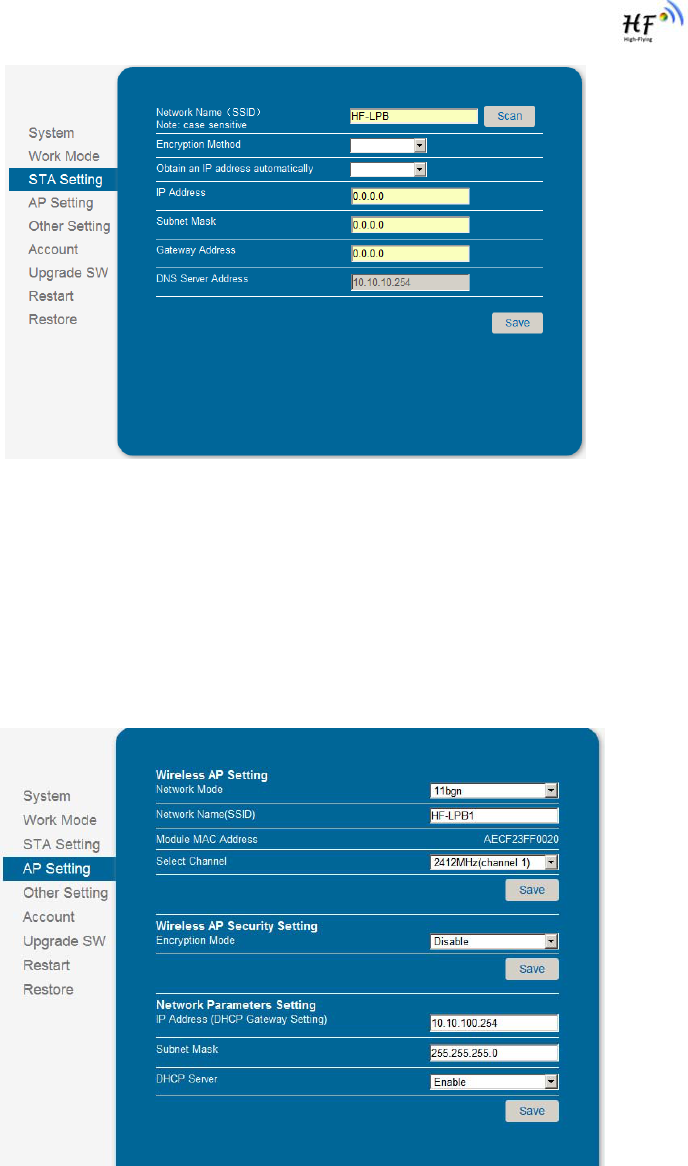
HF-LPB Low Power WiFi Module User Manual
Shanghai High-Flying Electronics Technology Co., Ltd
www.hi-flying.com
- 29 -
Figure 18. STA Setting Page
3.1.5. AP Setting Page
When user select module works at AP and AP+STA mode, then need setting this page and provide
wireless and network parameters. Most of the system support DHCP to achieve IP address, so we
suggest to “Enable” DHCP server in most applications.
Figure 19. AP Setting Page
3.1.6. Other Setting Page
HF-LPB usually works at data transparent transmission mode. At this mode, the user device which
connected with HF-LPB will connect and communicate with remote PC or server. At this page, user
need setting serial port communication parameters and defines TCP related protocal parameters.
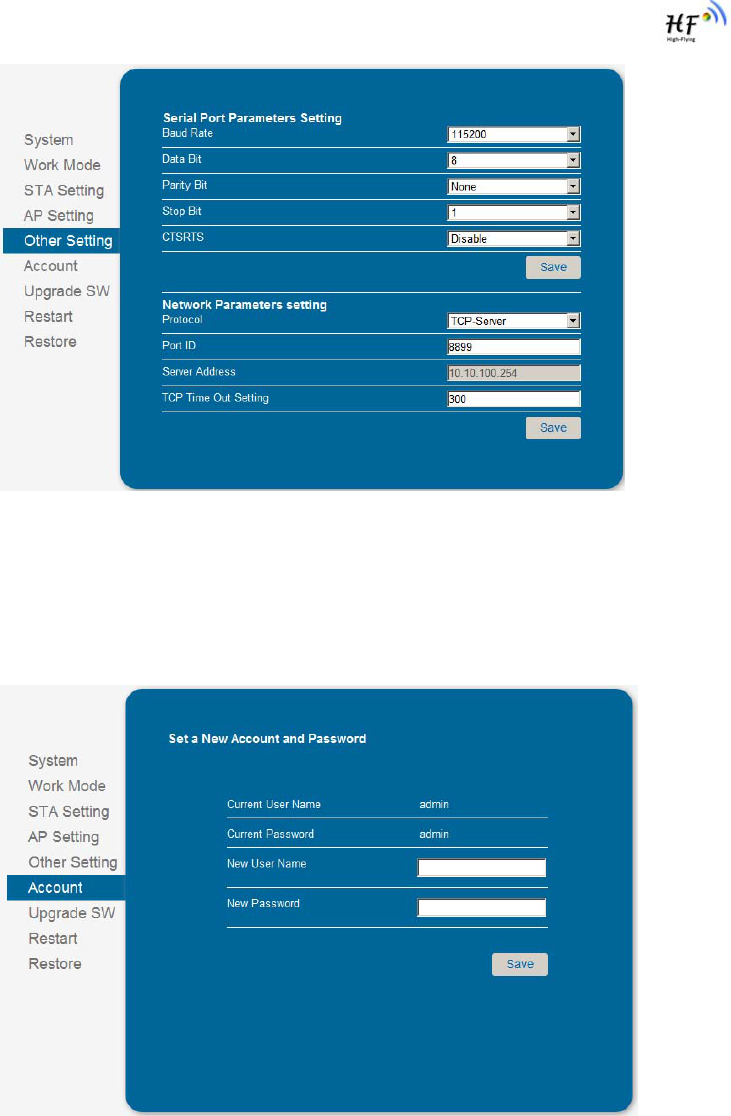
HF-LPB Low Power WiFi Module User Manual
Shanghai High-Flying Electronics Technology Co., Ltd
www.hi-flying.com
- 30 -
Figure 20. Other Setting Page
3.1.7. Account Management Page
This page set web server’s user name and password.
Figure 21. Account Page
3.1.8. Upgrade Software Page
User can upgrade new software (firmware) version through Wi-Fi.
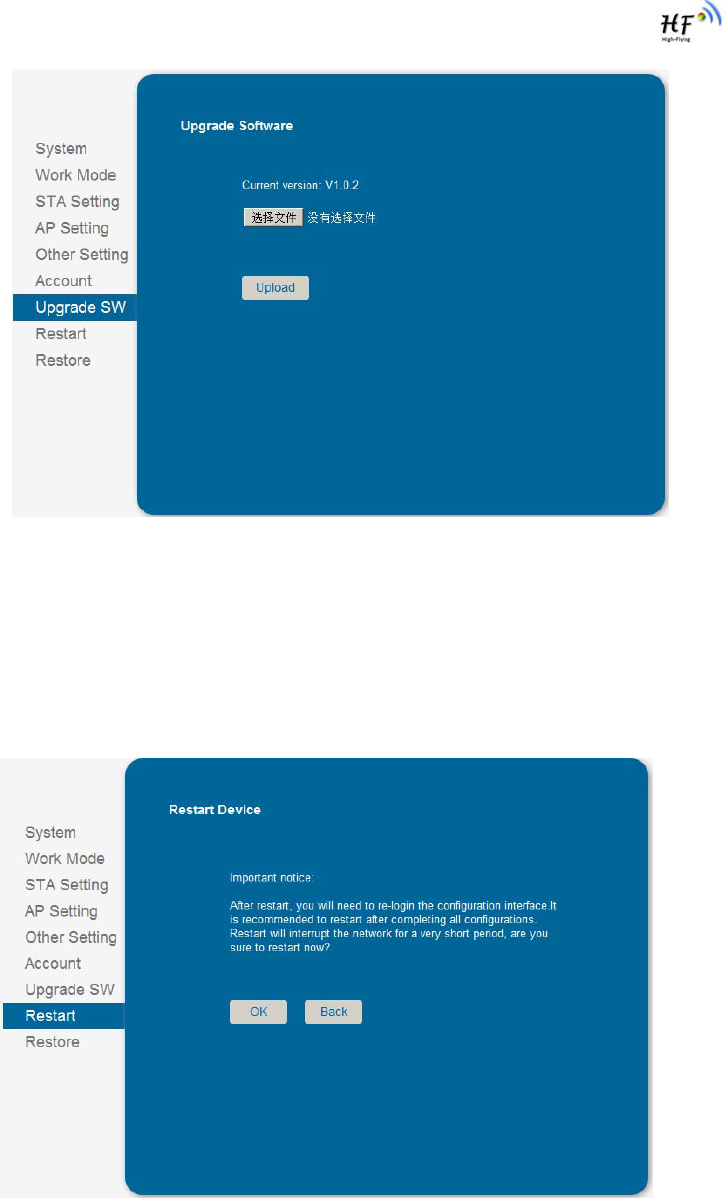
HF-LPB Low Power WiFi Module User Manual
Shanghai High-Flying Electronics Technology Co., Ltd
www.hi-flying.com
- 31 -
Figure 22. Upgrade SW page
3.1.9. Restart Page
Most of the settting and configuration can only effective after system restart. User shall restart after
finish all setting.
Figure 23. Restart Page
3.1.10. Restore Page
After module restore factory default setting, all user configuration profile will lose.
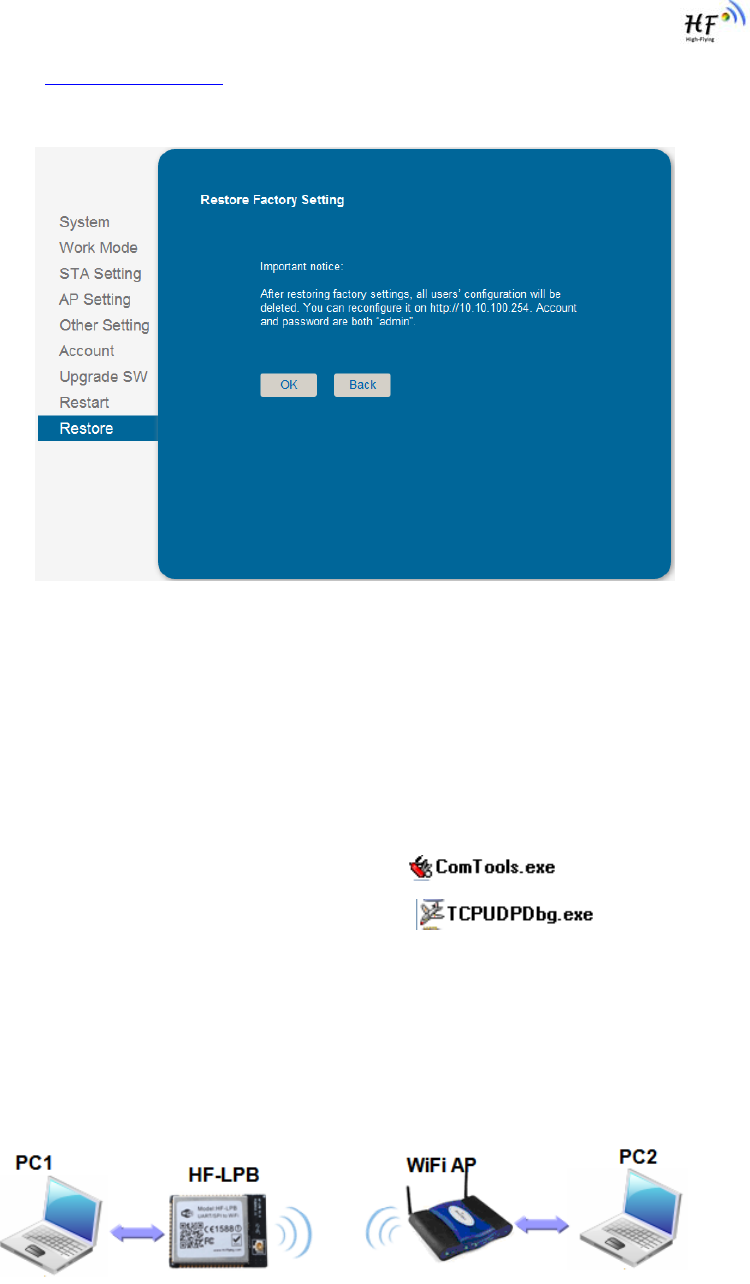
HF-LPB Low Power WiFi Module User Manual
Shanghai High-Flying Electronics Technology Co., Ltd
www.hi-flying.com
- 32 -
User can access http://10.10.100.254 to set again, and user name and password is “admin”. HF-LPB
will restore to AP mode for factory default setting.
Figure 24. Restore Page
3.2. HF-LPB Usage Introduction
3.2.1. Software Debug Tools
High-Flying use two common software tools debugging and applying HF-LPB module.
(User can also select other tools used to debug serial port).
Serial Debugging Software: ComTools
Ethernet Debugging Software: TCPUDPDbg
3.2.2. Network Connection
User can select two methods to connect HF-LPB module base on dedicated application.
¾ Use HF-LPB STA interface. HF-LPB and debug PC2 connect to a wireless AP, another
PC1 (or user device) connect to HF-LPB module with serial port:
Figure 25. STA Interface Debug Connection
¾ Use HF-LPB AP interface. Debug PC2 connect to HF-LPB through wireless connection,
another PC1 (or user device) connect to HF-LPB module with serial port.
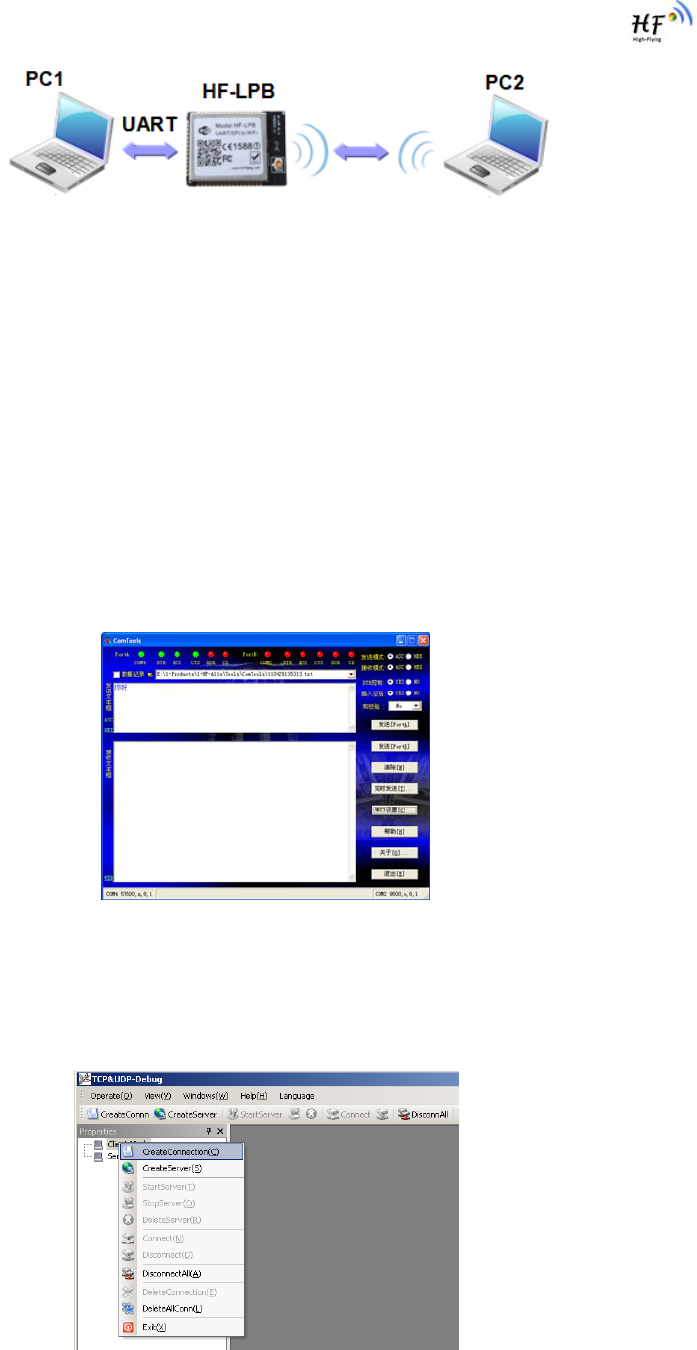
HF-LPB Low Power WiFi Module User Manual
Shanghai High-Flying Electronics Technology Co., Ltd
www.hi-flying.com
- 33 -
Figure 26. AP Interface Debug Connection
3.2.3. Default Parameter Setting
Default SSID: HF-LPB;
Deault security mode: open,none;
User UART parameter setting:115200,8,1,None;
Default network parameter setting:TCP,Server,8899,10.10.100.254;
Module IP address: dhcp,0.0.0.0,0.0.0.0,0.0.0.0;
3.2.4. Module Debug
PC1 open “CommTools” program, setting the same serial port parameters with HF-LPB module and
open serial port connection.
Figure 27. “CommTools” Serial Debug Tools
PC2 open “TCPUDPDbg” program, and create a new connection. If HF-LPB configured as Server
mode, “TCPUDPDbg” Tools shall create “Client “mode connection. Or otherwise, create a “Server”
mode connection.
Figure 28. “TCPUDPDbg” Tools Create Connection
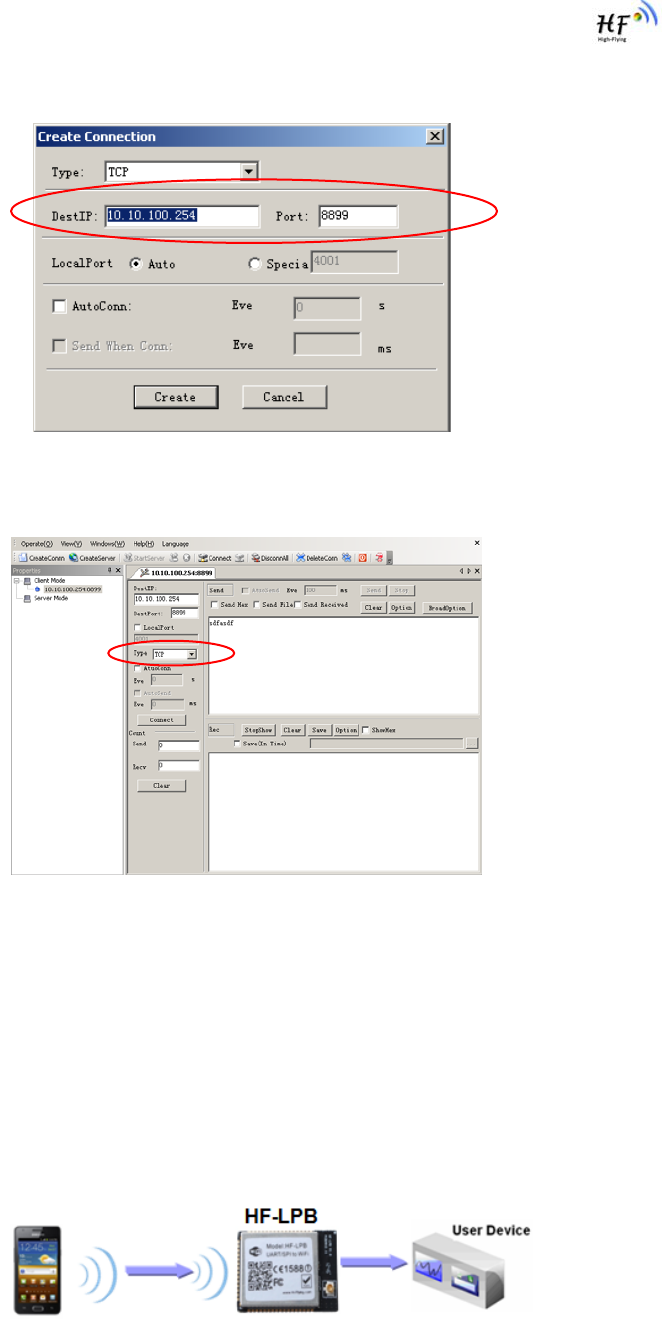
HF-LPB Low Power WiFi Module User Manual
Shanghai High-Flying Electronics Technology Co., Ltd
www.hi-flying.com
- 34 -
Then setting the TCP/UDP connection parameters. Default as following:
Figure 29. “TCPUDPDbg” Tools Setting
Then, click “Create” button to create a connection.
Figure 30. “TCPUDPDbg” Tools Connection
Now, in transparent transmission mode, data can be transferred from “CommTools” program to
“TCPUDPDbg” program, or in reverse. You can see data in receiver side will keep same as in sender
side.
3.3. Typical Application Examples
3.3.1. Wireless Control Application
Figure 31. Wireless Control Application
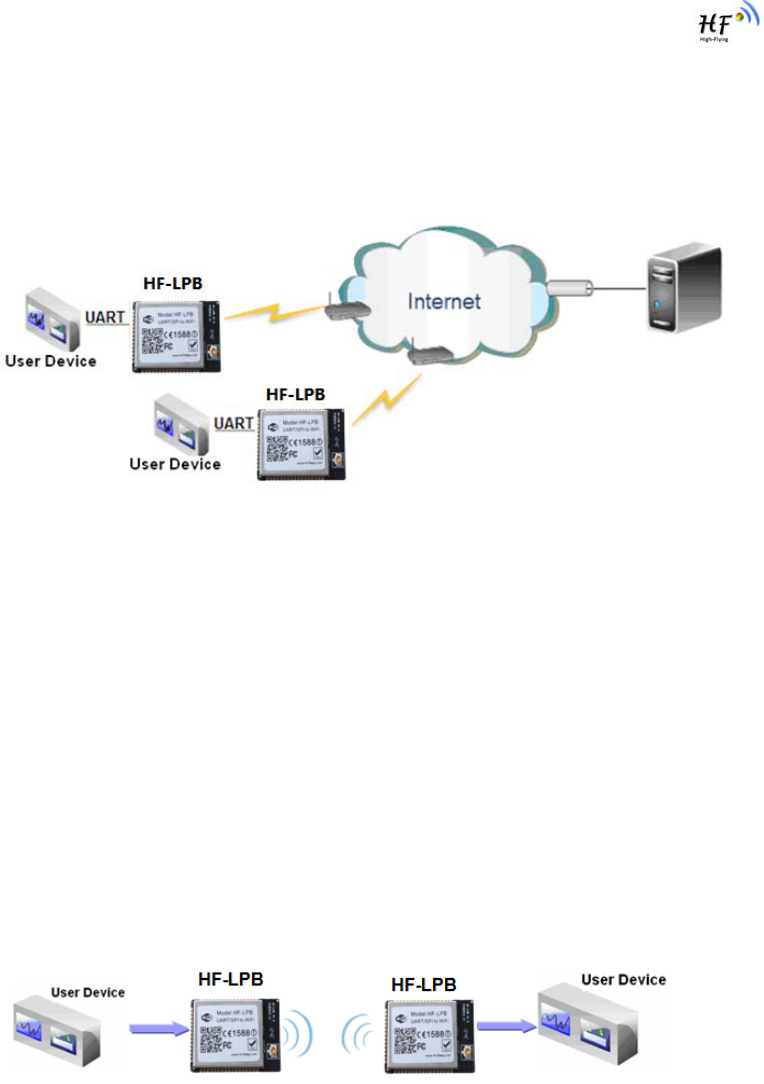
HF-LPB Low Power WiFi Module User Manual
Shanghai High-Flying Electronics Technology Co., Ltd
www.hi-flying.com
- 35 -
For this wireless control application, HF-LPB works as Ad-Hoc mode. Module’s serial port connects to
user device. So, control agent (Smart phone for this example) can manage and control the user
device through the wireless connection with HF-LPB module.
3.3.2. Remote Management Application
Figure 32. Remote Management Application
For this remote management application, HF-LPB works as STA mode and connects to Internet
through wireless AP. Module configured as TCP Client and communicates with remote TCP server at
Internet. Module’s serial port connects to user device.
So, user device’s data or sampling information can send to remote TCP server for storage or
processing. Also remote TCP server can send command to control and manage the user device
through the wireless network.
3.3.3. Transparent Serial Port Application
For this transparent serial port application, two HF-LPB modules connect as below figures to build up
a transparent serial port connection. HF-LPB works as Ad-Hoc mode to connect each other.
Figure 33. Transparent Serial Port Application
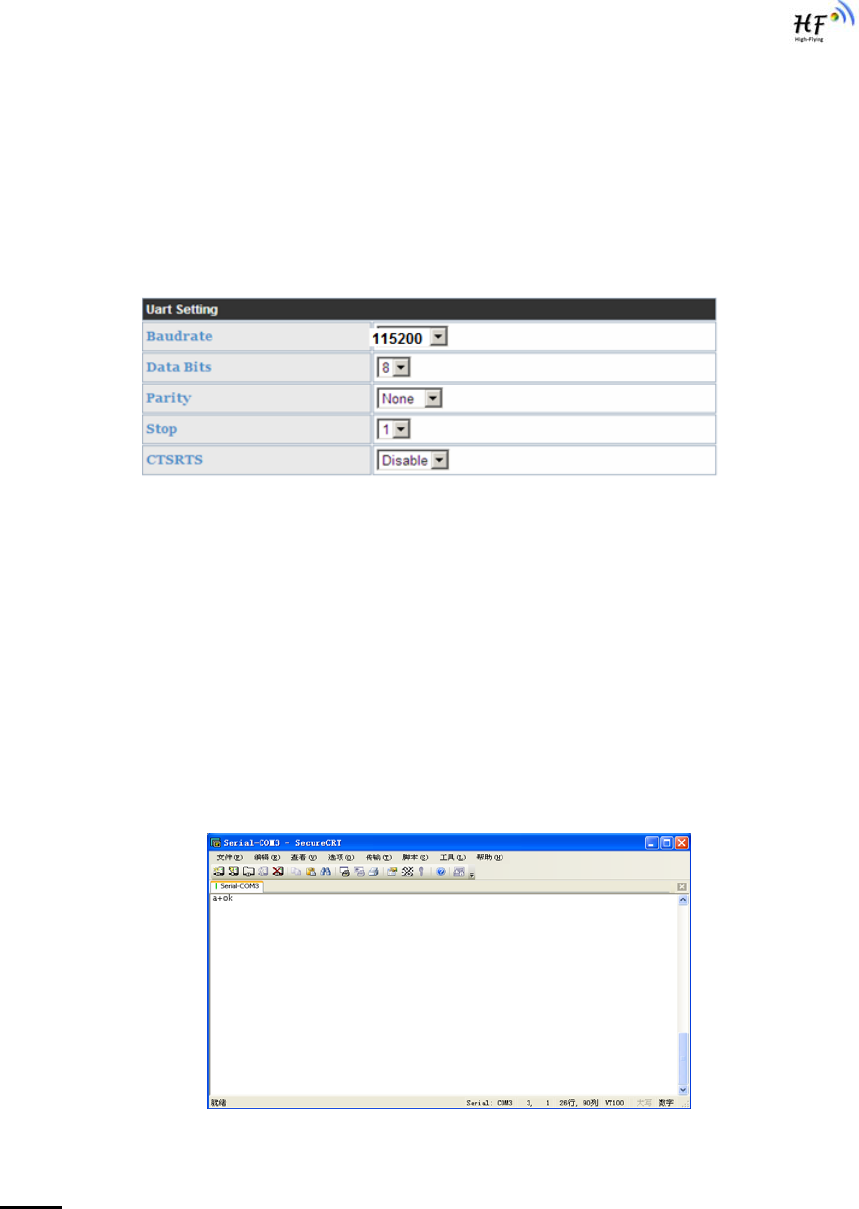
HF-LPB Low Power WiFi Module User Manual
Shanghai High-Flying Electronics Technology Co., Ltd
www.hi-flying.com
- 36 -
4. AT+INSTRUCTION INTRODUCTION
4.1. Configuration Mode
When HF-LPB power up, it will default works as transparent transmission mode, then user can switch
to configuration mode by serial port command. HF-LPB UART default parameters setting as below
figure,
Figure 34. HF-LPB Default UART Port Parameters
In configuration mode, user can setting the module through AT+ instruction set, which cover all web
page setting function.
4.1.1. Switch to Configuration Mode
Two steps to finish switching from transparent transmission mode to configuration mode.
¾ UART input “+++”, after module receive “+++”, and feedback “a” as confirmation.
¾ UART input “a”, after module receive “a” and feedback “+ok” to go into AT+
instruction set configuration mode.
Figure 35. Switch to Configuration Mode
Notes:
1. When user input “+++” (No “Enter” key required), the UART port will display feedback information
“a”, and not display input information”+++” as above UART display.
2. Any other input or wrong step to UART port will cause the module still works as original mode
(transparent transmission).
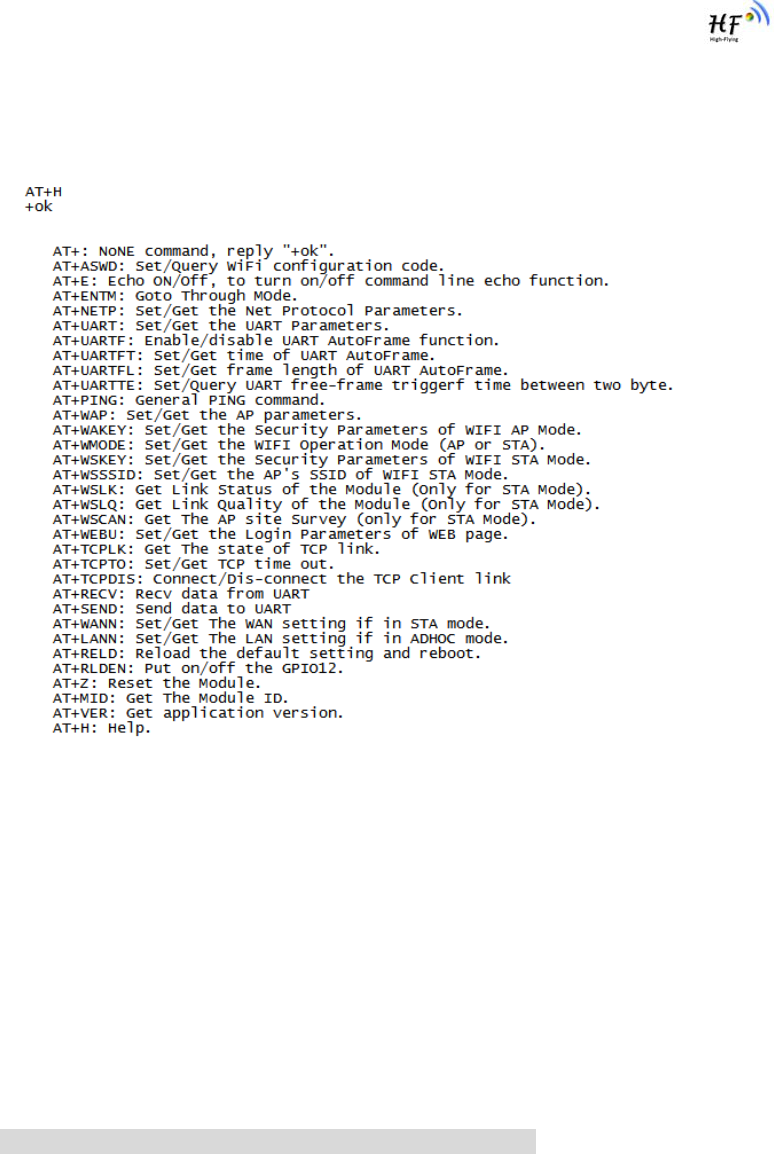
HF-LPB Low Power WiFi Module User Manual
Shanghai High-Flying Electronics Technology Co., Ltd
www.hi-flying.com
- 37 -
4.2. AT+ Instruction Set Overview
User can input AT+ Instruction through hyper terminal or other serial debug terminal, also can
program the AT+ Instruction to script. User can also input “AT+H” to list all AT+ Instruction and
description to start.
Figure 36. ”AT+H” Instruction for Help
4.2.1. Instruction Syntax Format
AT+Instruction protocol is based on the instruction of ASCII command style, the description of syntax
format as follow.
¾ Format Description
< >: Means the parts must be included
[ ]: Means the optional part
¾ Command Message
AT+<CMD>[op][para-1,para-2,para-3,para-4…]<CR>
AT+: Prefix of command message;
CMD: Command string;
[op]: Symbol of command operator,
“=” : The command requires parameters input;
“NULL”: Query the current command parameters setting;
[para-n]: Parameters input for setting if required;
<CR>:”Enter” Key, it’s 0x0a or 0x0d in ASCII;
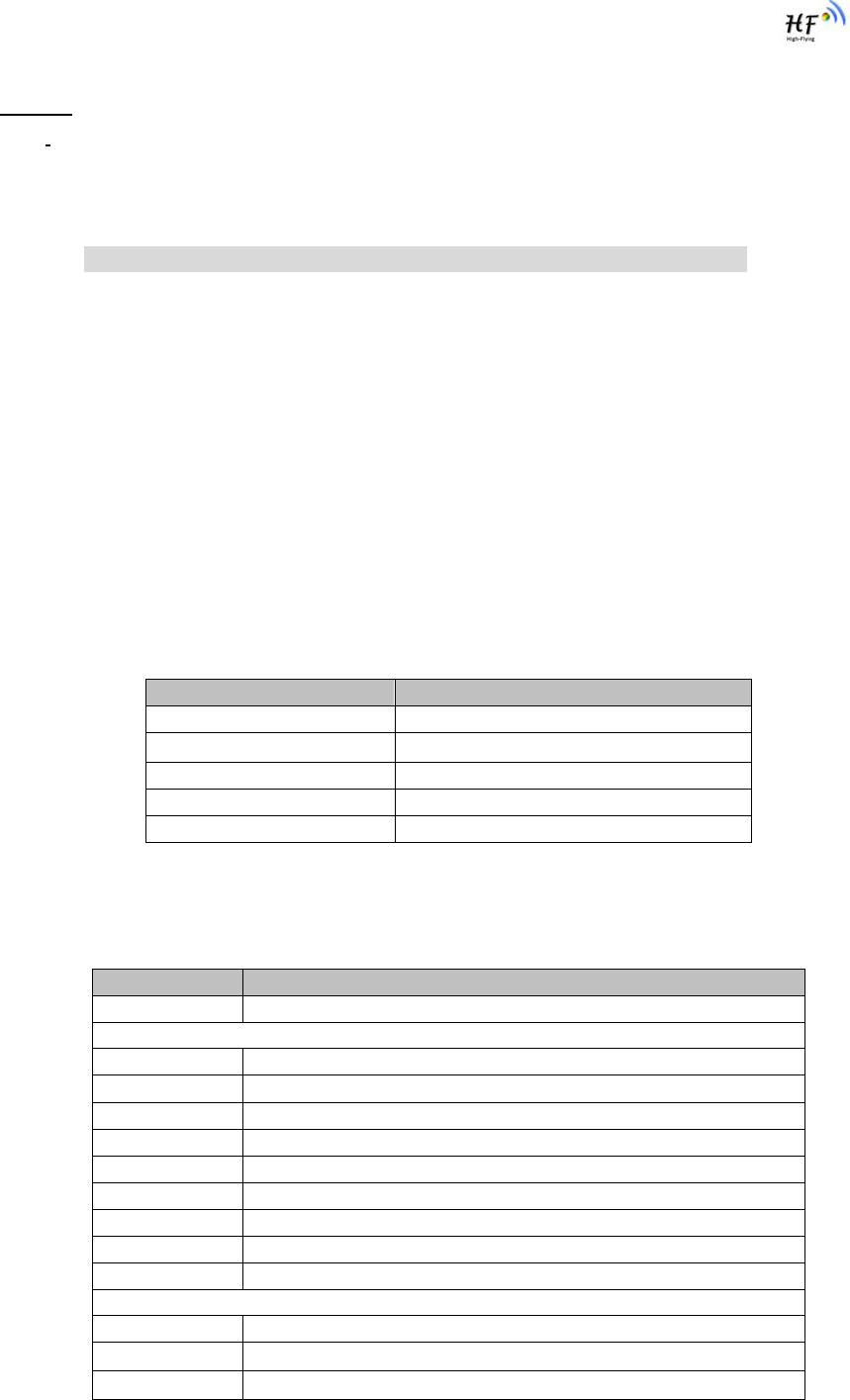
HF-LPB Low Power WiFi Module User Manual
Shanghai High-Flying Electronics Technology Co., Ltd
www.hi-flying.com
- 38 -
Notes: When input AT+Instruction, “AT+<CMD>” character will display capital letter automatic and
other parts will not change as you input.
¾ Response Message
+<RSP>[op] [para-1,para-2,para-3,para-4…]<CR><LF><CR><LF>
+: Prefix of response message;
RSP: Response string;
“ok” : Success
“ERR”: Failure
[op] : =
[para-n]: Parameters if query command or Error code when error happened;
<CR>: ASCII 0x0d;
<LF>: ASCIII 0x0a;
¾ Error Code
Table 10 Error Code Describtion
Error Code Description
-1 Invalid Command Format
-2 Invalid Command
-3 Invalid Operation Symbol
-4 Invalid Parameter
-5 Operation Not Permitted
4.2.2. AT+ Instruction Set
Table 11 AT+ Instruction Set List
Instruction Description
<null> NULL
Managment Instruction Set
E Open/Close show back function
WMODE Set/Query Wi-Fi work mode (AP/STA/APSTA)
ENTM Set module into transparent transition mode
TMODE Set/Query module data transfer mode
MID Query module ID information
VER Query module software version information
RELD Restore to factory default setting
Z Re-start module
H Help
UART Instruction Set
UART Set/Query serial port parameters
UARTF Open/Close UART auto-frame function
UARTFT Set/Query UART auto-frame trigger time

HF-LPB Low Power WiFi Module User Manual
Shanghai High-Flying Electronics Technology Co., Ltd
www.hi-flying.com
- 39 -
UARTFL Set/Query UART auto-frame trigger length
UARTTE Set/Query UART free-frame triggerf time between two bytes
Command Mode Set
SEND Send Data at Command Mode
RECV Receive Data at Command Mode
Network Instruction Set
PING Network ”Ping” Instruction
NETP Set/Query network protocol parameters
TCPLK Query if TCP link already build-up
TCPTO Set/Query TCP timeout
TCPDIS Open/Close TCP link
Wi-Fi STA Instruction Set (Effective when module works as STA)
WSKEY Set/Query STA security parameters
WSSSID Set/Query associated AP SSID parameters
WANN Set/Query STA’s network parameters
WSMAC Set/Query STA’s MAC address
WSLK Query STA Wi-Fi link status
WSLQ Query STA Wi-Fi signal strength
WSCAN Scan AP
WiFi AP Instruction Set (Effective when module works as AP)
LANN Set/Query AP’s network parameters
WAP Set/Query AP Wi-Fi parameters
WAKEY Set/Query AP security parameters
WAMAC Set/Query AP MAC address
WADHCP Set/Query AP DHCP Server status
Webpage Management Instruction Set
WEBSWITCH Set Webpage Option
Power Management Instruction Set
PSPAR Set/Query power save parameters at NORMAL mode
MSOPT Set/Query wake up option parameters
MSLP Set/Query deep sleep/standby mode parameters
TSPAR Set/Query timeout wake up parameters
Others Instruction Set
WRMID Set module ID
ASWD Set/Query WiFi configuration code
<Notes>:
All Power Management Instruction Set NOT support in this version.
4.2.2.1. AT+E
Function: Open/Close show back function;
Format:
AT+E<CR>
+ok<CR>< LF ><CR>< LF >
When HF-LPB module firstly switch from transparent transmission to configuration mode, show back
status is open, input “AT+E” to close show back function, input“AT+E” again to open show back
function.

HF-LPB Low Power WiFi Module User Manual
Shanghai High-Flying Electronics Technology Co., Ltd
www.hi-flying.com
- 40 -
4.2.2.2. AT+WMODE
Function: Set/Query WIFI work mode;
Format:
Query Operation
AT+WMODE<CR>
+ok=<mode><CR>< LF ><CR>< LF >
Set Operation
AT+ WMODE=<mode><CR>
+ok<CR>< LF ><CR>< LF >
Parameters:
mode:Wi-Fi work mode
AP
STA
APSTA
4.2.2.3. AT+ENTM
Function: Set module into transparent transmition mode;
Format:
AT+ENTM<CR>
+ok<CR>< LF ><CR>< LF >
When operate this command, module switch from configuration mode to transparent transmission
mode.
4.2.2.4. AT+TMODE
Function: Set/Query module data transfer mode.
Format:
Query Operation
AT+TMODE<CR>
+ok=<tmode><CR>< LF ><CR>< LF >
Set Operation
AT+TMODE=<tmode><CR>
+ok<CR>< LF ><CR>< LF >
Parameters:
tmode: data transfer mode, include:
throughput
cmd
4.2.2.5. AT+MID
Function: Query module ID information;
Format:
Query Operation
AT+MID<CR>
+ok=<module_id><CR>< LF ><CR>< LF >

HF-LPB Low Power WiFi Module User Manual
Shanghai High-Flying Electronics Technology Co., Ltd
www.hi-flying.com
- 41 -
Parameters:
module_id: Module ID information;
HF-LPB;
Notes: User can set this parameter through AT+WRMID.
4.2.2.6. AT+VER
Function: Query module software version information;
Format:
Query Operation
AT+VER<CR>
+ok=<ver><CR>< LF ><CR>< LF >
Parameters:
ver: Module software version information;
4.2.2.7. AT+RELD
Function: module restore to factory default setting;
Format:
Set Operation
AT+ RELD<CR>
+ok=rebooting…<CR>< LF ><CR>< LF >
When operate this command, module will restore to factory default setting and reboot.
4.2.2.8. AT+Z
Function: Re-start module;
Format:
AT+ Z<CR>
4.2.2.9. AT+H
Function: Help;
Format:
Query Operation
AT+H<CR>
+ok=<command help><CR>< LF ><CR>< LF >
Parameters:
command help: command introduction;
4.2.2.10. AT+UART
Function: Set/Query serial port parameters;
Format:
Query Operation
AT+UART<CR>
+ok=<baudrate,data_bits,stop_bit,parity><CR>< LF ><CR>< LF >
Set Operation
AT+UART=<baudrate,data_bits,stop_bit,parity><CR>

HF-LPB Low Power WiFi Module User Manual
Shanghai High-Flying Electronics Technology Co., Ltd
www.hi-flying.com
- 42 -
+ok<CR>< LF ><CR>< LF >
Parameters:
baudrate:
300,600,1200,1800,2400,4800,9600,19200,38400,57600,115200,230400,
380400,460800.
data_bits:
8
stop_bits:
1,2
parity:
NONE
EVEN
ODD
Flowctrl: (CTSRTS)
NFC: No hardware flow control
FC: hardware flow control
4.2.2.11. AT+ UARTF
Function: Open/Close UART auto-frame function;
Format:
Query Operation
AT+ UARTF<CR>
+ok=<para><CR>< LF ><CR>< LF >
Set Operation
AT+ UARTF=<para ><CR>
+ok<CR>< LF ><CR>< LF >
Parameters:
para:
disable - Close auto-frame function;
enable - Open auto-frame function;
4.2.2.12. AT+ UARTFT
Function: Set/Query UART auto-frame trigger time;
Format:
Query Operation
AT+ UARTFT<CR>
+ok=<time><CR>< LF ><CR>< LF >
Set Operation
AT+ UARTFT=<time ><CR>
+ok<CR>< LF ><CR>< LF >
Parameters:
time: Range 100 ~10000; Unit: ms. Auto-frame trigger time

HF-LPB Low Power WiFi Module User Manual
Shanghai High-Flying Electronics Technology Co., Ltd
www.hi-flying.com
- 43 -
4.2.2.13. AT+ UARTFL
Function: Set/Query UART auto-frame trigger length;
Format:
Query Operation
AT+ UARTFL<CR>
+ok=<len><CR>< LF ><CR>< LF >
Set Operation
AT+ UARTFL=<len ><CR>
+ok<CR>< LF ><CR>< LF >
Parameters:
len: Range 16 ~1400; Unit: Byte. Auto-frame trigger length;
4.2.2.14. AT+ UARTTE
Function: Set/Query UART free-frame trigger time between two bytes;
Format:
Query Operation
AT+ UARTTE<CR>
+ok=<mode><CR>< LF ><CR>< LF >
Set Operation
AT+ UARTTE=<mode><CR>
+ok<CR>< LF ><CR>< LF >
Parameters:
mode:
fast: free-frame trigger time between two bytes is 10ms;
normal: free-frame trigger time between two bytes is 50ms;
4.2.2.15. AT+ SEND
Function:
Send Data at Command Mode.
Format:
AT+SEND=<data_lenth, data_content><CR>
+ok<CR>< LF ><CR>< LF >
Parameters:
data_lenth: Lenth of send data. Range: 0~1000 Byte
data_content: contents of send data.
When two parameters conflict, select smaller value to send data.
4.2.2.16. AT+ RECV
Function:
Receive Data at Command Mode.
Format:
AT+RECV=<data_lenth><CR>
+ok=< data_lenth, data_content><CR>< LF ><CR>< LF >
Parameters:
data_lenth: Lenth of receive data. Range: 0~1000 Byte

HF-LPB Low Power WiFi Module User Manual
Shanghai High-Flying Electronics Technology Co., Ltd
www.hi-flying.com
- 44 -
data_content: contents of receive data.
If not receive any data in 3 second, then feedback +ok=0.
4.2.2.17. AT+ PING
Function: Network “PING” Instruction.
Format:
Set Operation
AT+ PING=<IP_address ><CR>
+ok=<sta><CR>< LF ><CR>< LF >
Parameters:
sta: feedback result
Success
Timeout
Unknown host
4.2.2.18. AT+NETP
Function: Set/Query network protocol parameters;
Format:
Query Operation
AT+NETP<CR>
+ok=<protocol,CS,port,IP><CR>< LF ><CR>< LF >
Set Operation
AT+NETP=<protocol,CS,port,IP><CR>
+ok<CR>< LF ><CR>< LF >
Parameters:
protocol:
TCP
UDP
CS: Network mode:
SERVER
CLIENT
Port: protocol port ID: Decimal digit and less than 65535
IP: Server’s IP address when module set as client
4.2.2.19. AT+ TCPLK
Function: Query if TCP link already build-up;
Format:
AT+ TCPLK<CR>
+ok=<sta><CR>< LF ><CR>< LF >
Parameters:
sta.: if module already setup TCP link;
on: TCP link setup;
off: TCP link not setup;

HF-LPB Low Power WiFi Module User Manual
Shanghai High-Flying Electronics Technology Co., Ltd
www.hi-flying.com
- 45 -
4.2.2.20. AT+ TCPTO
Function: Set/Query TCP timeout;
Format:
Query Operation
AT+ TCPTO<CR>
+ok=<time><CR>< LF ><CR>< LF >
Set Operation
AT+ TCPTO=<time ><CR>
+ok<CR>< LF ><CR>< LF >
Parameters:
time: TCP timeout time.
<= 600, (600s);
>=0, (0 means no timeout);
Default, 300s;
4.2.2.21. AT+TCPDIS
Function:
Open/Close TCP link;
Format:
Query Opera
AT+TCPDIS<CR>
+ok=<sta><CR>< LF ><CR>< LF >
Set Operation
AT+ TCPDIS =<on/off><CR>
+ok<CR>< LF ><CR>< LF >
Parameters:
When query, sta.: Feedback if TCP Client can be link,
On, TCP link close
off,TCP link on
When setting, “off” means close TCP link. After finish this command, module disconnect
TCP link and not connect again. “On” means open TCP link. After finish this command,
module re-connect TCP server right away.
4.2.2.22. AT+WSSSID
Function: Set/Query Wi-Fi associated AP SSID parameters.
Format:
Query Operation
AT+WSSSID<CR>
+ok=<ap’s ssid><CR>< LF ><CR>< LF >
Set Operation
AT+ WSSSID=<ap’s ssid ><CR>
+ok<CR>< LF ><CR>< LF >
Parameters:
ap’s ssid: AP’s SSID (Within 32 character);

HF-LPB Low Power WiFi Module User Manual
Shanghai High-Flying Electronics Technology Co., Ltd
www.hi-flying.com
- 46 -
4.2.2.23. AT+WSKEY
Function: Set/Query STA security parameters;
Format:
Query Operation
AT+WSKEY<CR>
+ok=<auth,encry,key><CR>< LF ><CR>< LF >
Set Operation
AT+ WSKEY=< auth,encry,key><CR>
+ok<CR>< LF ><CR>< LF >
Parameters:
auth: Authentication mode
OPEN
SHARED
WPAPSK
WPA2PSK
encry:Encryption algorithm
NONE: When “auth=OPEN”, effective
WEP: When “auth=OPEN” or “SHARED”, effective
TKIP: When ”auth= WPAPSK” or “WPA2PSK”, effective
AES: When “auth= WPAPSK” “WPA2PSK”, effective
key: password, ASCII code, shall less than 64 bit and greater than 8bit
4.2.2.24. AT+ WANN
Function: Set/Query STA network setting;
Format:
Query Operation
AT+WANN<CR>
+ok=<mode,address,mask,gateway><CR>< LF ><CR>< LF >
Set Operation
AT+ WANN=< mode,address,mask,gateway ><CR>
+ok<CR>< LF ><CR>< LF >
Parameters:
mode: STA’s IP network setting
static: Static IP
DHCP: Dynamic IP
address: STA IP address;
mask: STA subnet mask;
gateway: STA gateway address;
4.2.2.25. AT+ WSMAC
Function: Set/Query STA MAC address parameters;
Format:
Query Operation

HF-LPB Low Power WiFi Module User Manual
Shanghai High-Flying Electronics Technology Co., Ltd
www.hi-flying.com
- 47 -
AT+WSMAC<CR>
+ok=<mac_address><CR>< LF ><CR>< LF >
Set Operation
AT+ WSMAC=<code,mac_address><CR>
+ok<CR>< LF ><CR>< LF >
Parameters:
code: security code
8888 (default value)
Mac_address: STA MAC address, such as ACCF23FF1234
4.2.2.26. AT+ WSLK
Function: Query STA WiFi link status
Format:
Query Operation
AT+ WSLK<CR>
+ok=<ret><CR>< LF ><CR>< LF >
Parameters:
ret
”Disconnected”, if no WiFi connection;
”AP’ SSID(AP’s MAC” ), if WiFi connection available;
”RF Off”, if WiFi OFF;
4.2.2.27. AT+ WSLQ
Function: Query STA WiFi signal strength;
Format:
Query Operation
AT+ WSLQ<CR>
+ok=<ret><CR>< LF ><CR>< LF >
Parameters:
ret
”Disconnected”, if no WiFi connection;
”AP’s WiFi signal strength” , if WiFi connection available;
4.2.2.28. AT+WSCAN
Function: Scan AP;
Format:
AT+ WSCAN<CR>
+ok=<ap_site><CR>< LF ><CR>< LF >
Parameters:
ap_site: AP searched;
4.2.2.29. AT+ LANN
Function: Set/Query AP’s network parameters;
Format:

HF-LPB Low Power WiFi Module User Manual
Shanghai High-Flying Electronics Technology Co., Ltd
www.hi-flying.com
- 48 -
Query Operation
AT+LANN<CR>
+ok=<ipaddress,mask><CR>< LF ><CR>< LF >
Set Operation
AT+ LANN=< ipaddress,mask><CR>
+ok<CR>< LF ><CR>< LF >
Parameters:
ipaddress: AP’s IP address;
mask: AP’s net mask;
4.2.2.30. AT+WAP
Function: Set/Query AP Wi-Fi parameters;
Format:
Query Operation
AT+WAP<CR>
+ok=<wifi_mode,ssid,channel><CR>< LF ><CR>< LF >
Set Operation
AT+ WAP =<wifi_mode,ssid,channel><CR>
+ok<CR>< LF ><CR>< LF >
Parameters:
wifi_mode: Wi-Fi mode, include:
11B
11BG
11BGN (Default Value)
ssid:SSID at AP mode
channel: Wi-Fi channel selection:
AUTO
CH1~CH11; (Default CH1)
4.2.2.31. AT+WAKEY
Function: Set/Query AP Wi-Fi secruity parameters;
Format:
Query Operation
AT+WAKEY<CR>
+ok=<auth,encry,key><CR>< LF ><CR>< LF >
Set Operation
AT+ WSKEY=< auth,encry,key><CR>
+ok<CR>< LF ><CR>< LF >
Parameters:
auth: include
OPEN
WPA2PSK
Encry: include
NONE: When “auth=OPEN” available;

HF-LPB Low Power WiFi Module User Manual
Shanghai High-Flying Electronics Technology Co., Ltd
www.hi-flying.com
- 49 -
AES: When “auth=WPA2PSK” available;
key: security code, ASCII code, smaller than 64bit and bigger than 8 bit;
4.2.2.32. AT+WAMAC
Function: Query AP MAC address parameters;
Format:
Query Operation
AT+WAMAC<CR>
+ok=<mac_address><CR>< LF ><CR>< LF >
Parameters:
mac_address:AP’s MAC address;
Note: Module AP mode’s MAC address is related to STA mode’s MAC address. If user need
changeto others, please contact with high-flying technical people.
4.2.2.33. AT+WADHCP
Function: Set/Query AP DHCP server status;
Format:
Query Operation
AT+WADHCP<CR>
+ok=<status><CR>< LF ><CR>< LF >
Set Operation
AT+ WADHCP=<status><CR>
+ok<CR>< LF ><CR>< LF >
Parameters:
status:AP’s DHCP server function status:
on:DHCP Server Open;
off:DHCP Server Close:
4.2.2.34. AT+WEBSWITCH
Function: Set Web page display option;
Format:
Set Operation
AT+ WEBSWITCH=<web><CR>
+ok<CR>< LF ><CR>< LF >
Parameters:
web:module’s web page option:
iw: select internal reduced version web page as default web page;
ew: select full version web page as default web page;
Note: “iw” web page only used to upgrade and upload customized web page; “ew” web
page provide more configuration option.
4.2.2.35. AT+PSPAR
Function: Set/ Query power save parameters at Normal mode;
Format:

HF-LPB Low Power WiFi Module User Manual
Shanghai High-Flying Electronics Technology Co., Ltd
www.hi-flying.com
- 50 -
Query Operation
AT+ PSPAR<CR>
+ok=<mode> <CR>< LF ><CR>< LF >
Set Operation
AT+ PSPAR=<mode> <CR>< LF ><CR>< LF >
Parameters:
mode:
pf:Continuous TX Mode (NO WiFi OFF)
ps1:Normal Mode, Disable DTIM (Default, 100ms interval)
ps2:Normal Mode, Enable DTIM
4.2.2.36. AT+MSLP
Function: Set/Query deep sleep/standby mode parameters;
Format:
Query Operation
AT+ MSLP<CR>
+ok=<ret><CR>< LF ><CR>< LF >
Set Operation
AT+ MSLP=<mode><CR>< LF ><CR>< LF >
Parameters:
ret:
normal: normal mode (ps1: 100ms interval)
deep sleep: deep sleep mode [WiFi OFF]
standby: WiFi shut down mode
mode:
normal: normal mode (ps1: 100ms interval)
dslp: deep sleep mode [WiFi OFF]
standby: WiFi shut down mode
Note: AT MSLP command can only be applied one time in every 10 second;
4.2.2.37. AT+MSOPT
Function: Set/Query wake up option parameters;
Format:
Query Operation
AT+ MSOPT<CR>
+ok=<wakeup_mode> <CR>< LF ><CR>< LF >
Set Operation
AT+ MSOPT=<wakeup_mode> <CR>< LF ><CR>< LF >
Parameters:
Wakeup_mode:
0b0001:UART Wake up
0b0010:Pin Wake up
0b0100:Timeout Wake up
Note: These 3 options can multi-selection, such as 0b0111 means all three wakes up option enabled.

HF-LPB Low Power WiFi Module User Manual
Shanghai High-Flying Electronics Technology Co., Ltd
www.hi-flying.com
- 51 -
4.2.2.38. AT+TSPAR
Function: Set/Query timeout wake up parameters;
Format:
Query Operation
AT+ TSPAR<CR>
+ok=<timeout> <CR>< LF ><CR>< LF >
Set Operation
AT+ TSPAR=<timeout> <CR>< LF ><CR>< LF >
Parameters:
timeout: set timeout time, unit: second.
4.2.2.39. AT+WRMID
Function: Set module ID;
Format:
Set Operation
AT+ WRMID=<wrmid> <CR>< LF ><CR>< LF >
Parameters:
wrmid: set module’s ID (within 20 characters).
4.2.2.40. AT+ASWD
Function: Set/Query WiFi Configuration Password;
Format:
Query Operation
AT+ ASWD<CR>
+ok=<aswd> <CR>< LF ><CR>< LF >
Set Operation
AT+ ASWD=<aswd> <CR>< LF ><CR>< LF >
Parameters:
aswd: WiFi Configuration Password (within 20 characters).
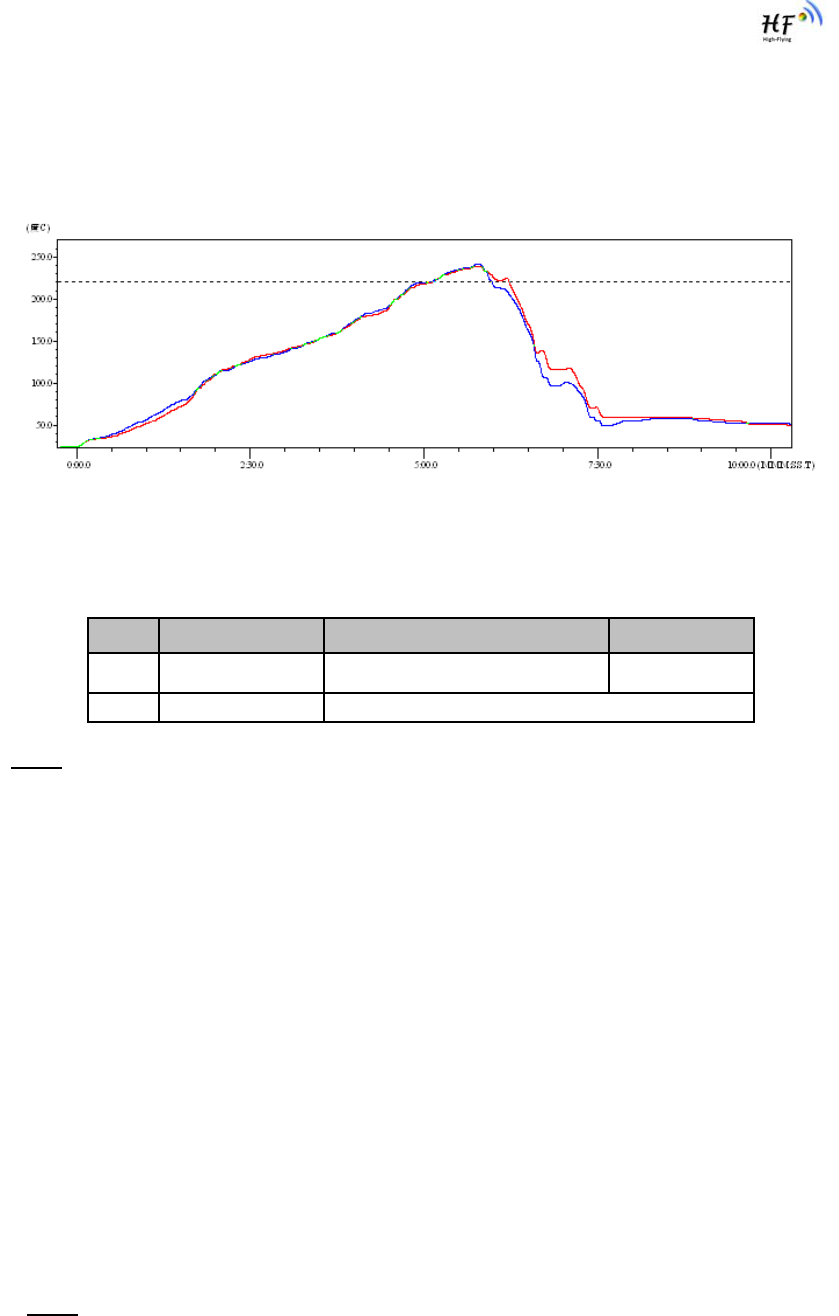
HF-LPB Low Power WiFi Module User Manual
Shanghai High-Flying Electronics Technology Co., Ltd
www.hi-flying.com
- 52 -
5. PACKAGE INFORMATION
5.1. Recommended Reflow Profile
Figure 37. Reflow Soldering Profile
Table 12 Reflow Soldering Parameter
Note: 1. Recommend to supply N2 for reflow oven.
2. N2 atmosphere during reflow (O2<300ppm)
5.2. Device Handling Instruction (Module IC SMT Preparation)
1. Shelf life in sealed bag: 12 months, at <30℃ and <60% relative humidity (RH)
2. After bag is opened, devices that will be re-baked required after last baked with window time
168 hours.
3. Recommend to oven bake with N2 supplied
4. Recommend end to reflow oven with N2 supplied
5. Baked required with 24 hours at 125+-5℃ before rework process for two modules, one is
new module and two is board with module
6. Recommend to store at ≦10% RH with vacuum packing
7. If SMT process needs twice reflow:
(1) Top side SMT and reflow (2) Bottom side SMT and reflow
Case 1: Wifi module mounted on top side. Need to bake when bottom side process over 168
hours window time, no need to bake within 168 hours
Case 2: Wifi module mounted on bottom side, follow normal bake rule before process
Note: Window time means from last bake end to next reflow start that has 168 hours space.
NO. Item Temperature (Degree) Time(Sec)
1 Reflow Time Time of above 220 35~55 sec
2 Peak-Temp 260 max
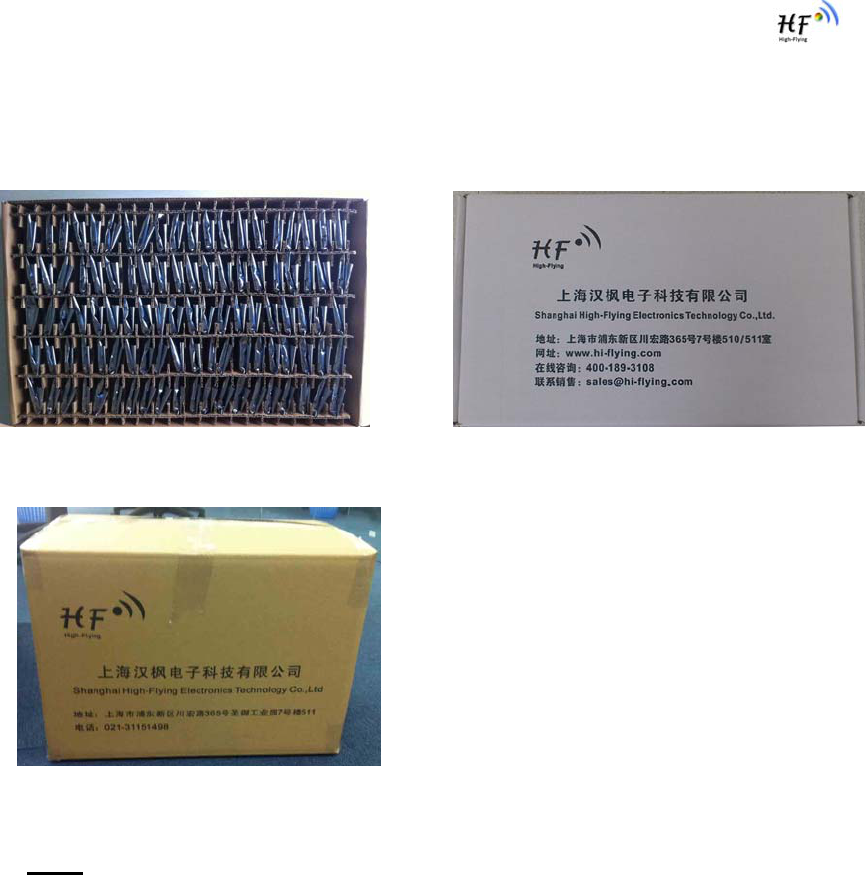
HF-LPB Low Power WiFi Module User Manual
Shanghai High-Flying Electronics Technology Co., Ltd
www.hi-flying.com
- 53 -
5.3. Shipping Information
TRAY BOX
Size: 420*245*34 mm Size: 422*247*72 mm (inside)
CARTON
Size: 440*260*320 mm (inside)
Figure 38. Shipping Information
Note:
1 tray = 5*20pcs = 100 pcs
1 box = 2 trays = 2 * 100 pcs = 200pcs
1 carton = 4 boxes = 4 * 200 pcs = 800pcs
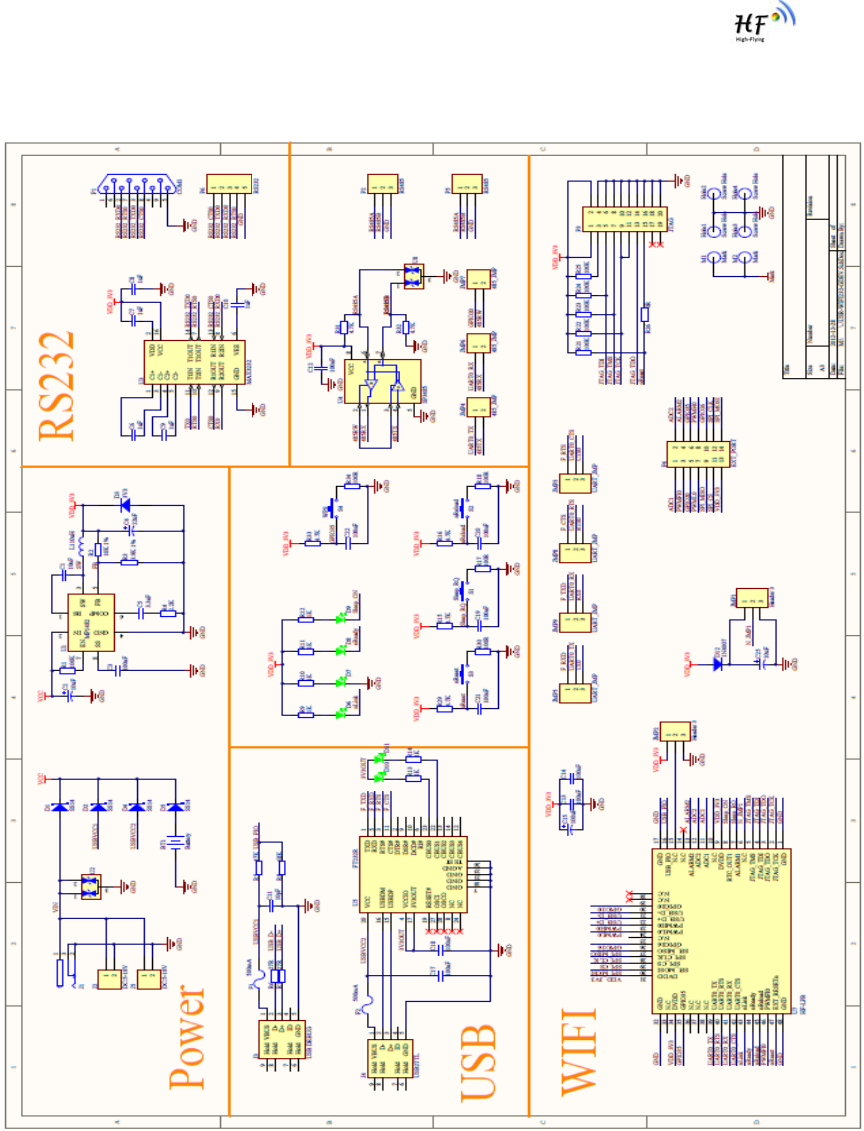
HF-LPB Low Power WiFi Module User Manual
Shanghai High-Flying Electronics Technology Co., Ltd
www.hi-flying.com
- 54 -
APPENDIX A: HW REFERENCE DESIGN
Detailed HF-LPB Evluation Board design source files, pls access High-Flying web download page or
contact with High-Flying technical support people to acquire.

HF-LPB Low Power WiFi Module User Manual
Shanghai High-Flying Electronics Technology Co., Ltd
www.hi-flying.com
- 55 -
APPENDIX B: CONTACT INFORMATION
------------------------------------------------------------------------------------------------------------
Address: Room.511/510, Building 7, No.365, Chuanhong Road, Pudong New Area,
Shanghai, China, 201202
Web: www.hi-flying.com
Service Online: 400-189-3108
Sales Contact: sales@hi-flying.com
-----------------------------------------------------------------------------------------------------------
For more information about High-Flying modules, applications, and solutions, please visit our web site
http://www.hi-flying.com/en/

HF-LPB Low Power WiFi Module User Manual
Shanghai High-Flying Electronics Technology Co., Ltd
www.hi-flying.com
- 56 -
FCC RF EXPOSURE REQUIREMENTS
1 STANDARDS AND REGULATORY COMPLIANCE
1.2 Standards and certification
The EUT conforms to the following standards and certification requirements:
802.11 b/g/n
FCC
❒ 47 CFR Part 1 - RF radiation exposure limits
❒ 47 CFR Part 2 - Equipment authorization
❒ 47 CFR Part C - WIFI
1.3 FCC certification requirements.
According to the definition of mobile and fixed device is described in Part 2.1091(b), this device is a
mobile device.
And the following conditions must be met:
1. The EUT is a mobile device; maintain at least a 20 cm separation between the EUT and the user’s
body and must not transmit simultaneously with any other antenna or transmitter.
2. The device is only for fixed operation mode. (A Class II Change would be required for near-body
Host applications.)
3. A label with the following statements must be attached to the host end product: This device
contains Tx FCC ID: AZY-HF-LPB.
4. To comply with FCC regulations limiting both maximum RF output power and human exposure to
RF radiation, maximum antenna gain (including cable loss) must not exceed:
❒ 802.11b band < 0.8 dBi

HF-LPB Low Power WiFi Module User Manual
Shanghai High-Flying Electronics Technology Co., Ltd
www.hi-flying.com
- 57 -
❒ 802.11g band <0.8 dBi
❒ 802.11n band <0.8 dBi
5. This module must not transmit simultaneously with any other antenna or transmitter
6. The host end product must include a user manual that clearly defines operating requirements and
conditions that must be observed to ensure compliance with current FCC RF exposure guidelines.
For portable devices, in addition to the conditions 3 through 6 described above, a separate approval
is required to satisfy the SAR requirements of FCC Part 2.1093
If the device is used for other equipment that separate approval is required for all other operating
configurations, including portable configurations with respect to 2.1093 and different antenna
configurations.
For this device, OEM integrators must be provided with labeling instructions of finished products.
Please refer to KDB784748 D01 v07, section 8. Page 6/7 last two paragraphs:
A certified modular has the option to use a permanently affixed label, or an electronic label. For a
permanently affixed label, the module must be labelled with an FCC ID - Section 2.926 (see 2.2
Certification (labelling requirements) above). The OEM manual must provide clear instructions
explaining to the OEM the labelling requirements, options and OEM user manual instructions that
are required (see next paragraph).
For a host using a certified modular with a standard fixed label, if (1) the module’s FCC ID is not
visible when installed in the host, or (2) if the host is marketed so that end users do not have
straightforward commonly used methods for access to remove the module so that the FCC ID of the
module is visible; then an additional permanent label referring to the enclosed module:“ Contains
Transmitter Module FCC ID: AZY-HF-LPB” or “Contains FCC ID: AZY-HF-LPB” must be used.
The host OEM user manual must also contain clear instructions on how end users can find and/or
access the module and the FCC ID.

HF-LPB Low Power WiFi Module User Manual
Shanghai High-Flying Electronics Technology Co., Ltd
www.hi-flying.com
- 58 -
The user manual or instruction manual for an intentional or unintentional radiator shall caution the
user that changes or modifications not expressly approved by the party responsible for compliance
could void the user's authority to operate the equipment. In cases where the manual is provided
only in a form other than paper, such as on a computer disk or over the Internet, the information
required by this section may be included in the manual in that alternative form, provided the user
can reasonably be expected to have the capability to access information in that form.
This device complies with part 15 of the FCC Rules. Operation is subject to the following two
conditions: (1) This device may not cause harmful interference, and (2) this device must accept any
interference received, including interference that may cause undesired operation.
Caution: Changes or modifications not expressly approved by the manufacturer could void the user’s
authority to operate the equipment.
1.4 FCC RF exposure requirements
1. Radiated transmit power must be equal to or lower than that specified in the FCC Grant of
Equipment Authorization for FCC ID: AZY-HF-LPB.
2. To comply with FCC regulations limiting both maximum RF output power and human exposure to
RF radiation, maximum antenna gain (including cable loss) must not exceed:
❒ 802.11b band < 0.8 dBi
❒ 802.11g band < 0.8 dBi
❒ 802.11n band <0.8 dBi
3. This module must not transmit simultaneously with any other antenna or transmitter.
4. To ensure compliance with all non-transmitter functions the host manufacturer is
responsible for ensuring compliance with the module(s) installed and fully operational. For
example, if a host was previously authorized as an unintentional radiator under the
Declaration of Conformity procedure without a transmitter certified module and a module is
added, the host manufacturer is responsible for ensuring that the after the module is installed
and operational the host continues to be compliant with the Part 15B unintentional radiator
requirements.
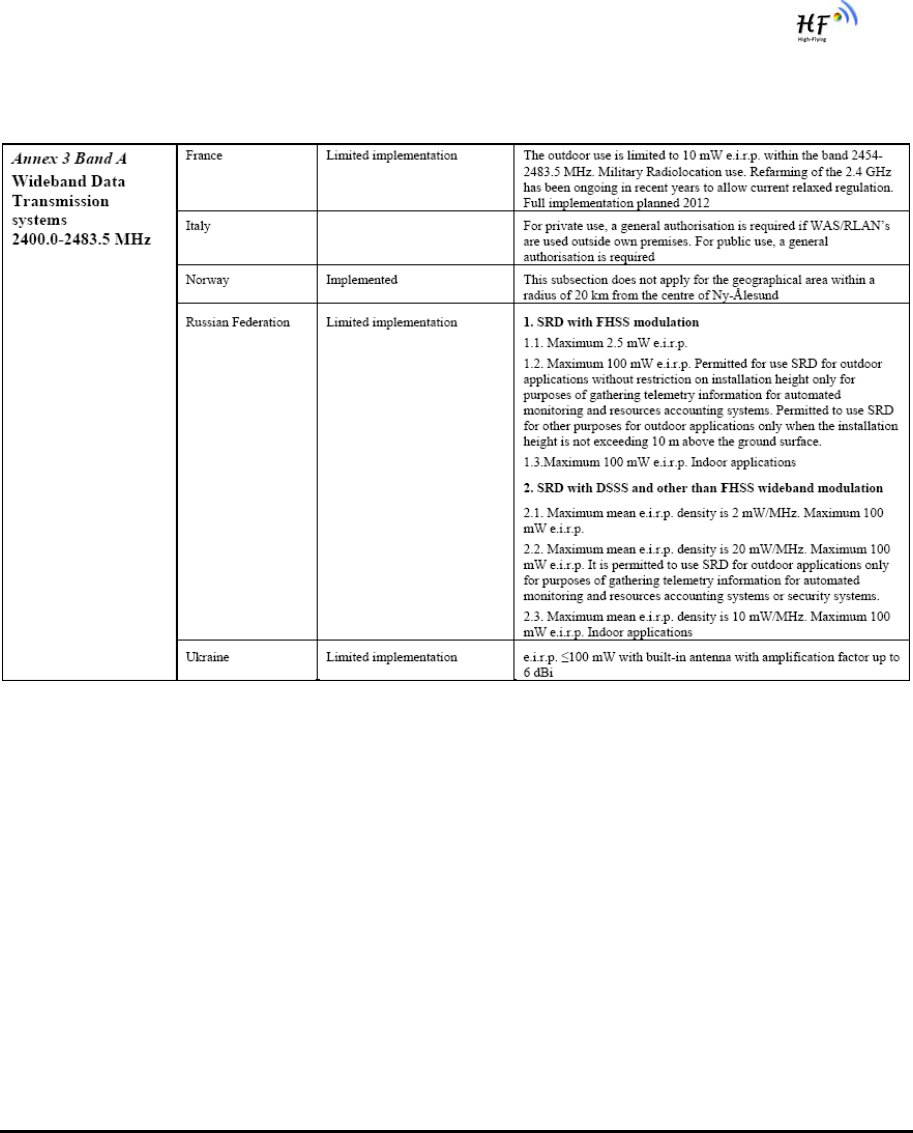
HF-LPB Low Power WiFi Module User Manual
Shanghai High-Flying Electronics Technology Co., Ltd
www.hi-flying.com
- 59 -
NATIONAL RESTRICTIONS-CE
END OF DOCUMENT
© Copyright High-Flying, May, 2011
The information disclosed herein is proprietary to High-Flying and is not to be used by or disclosed to unauthorized persons
without the written consent of High-Flying. The recipient of this document shall respect the security status of the information.
The master of this document is stored on an electronic database and is “write-protected” and may be altered only by
authorized persons at High-Flying. Viewing of the master document electronically on electronic database ensures access to
the current issue. Any other copies must be regarded as uncontrolled copies.